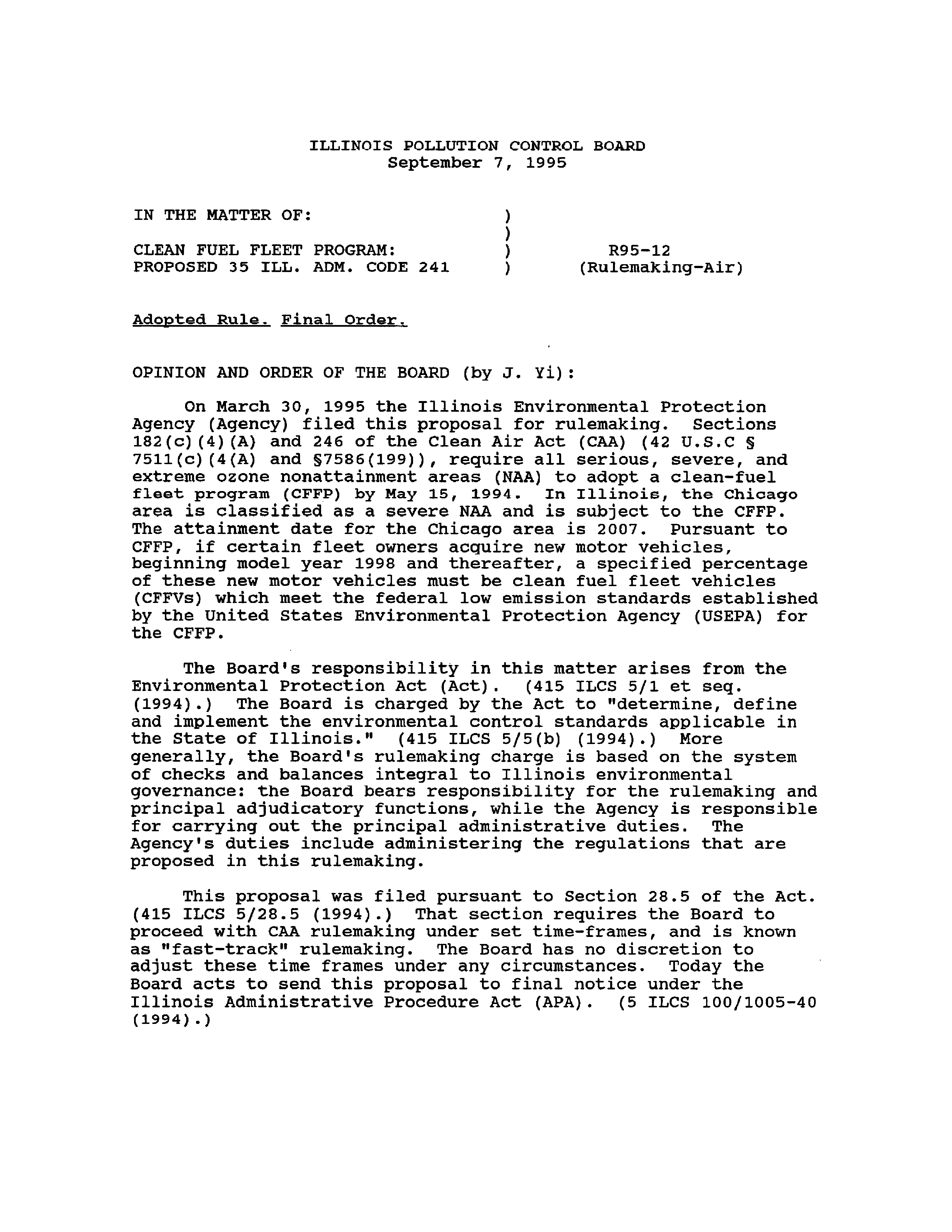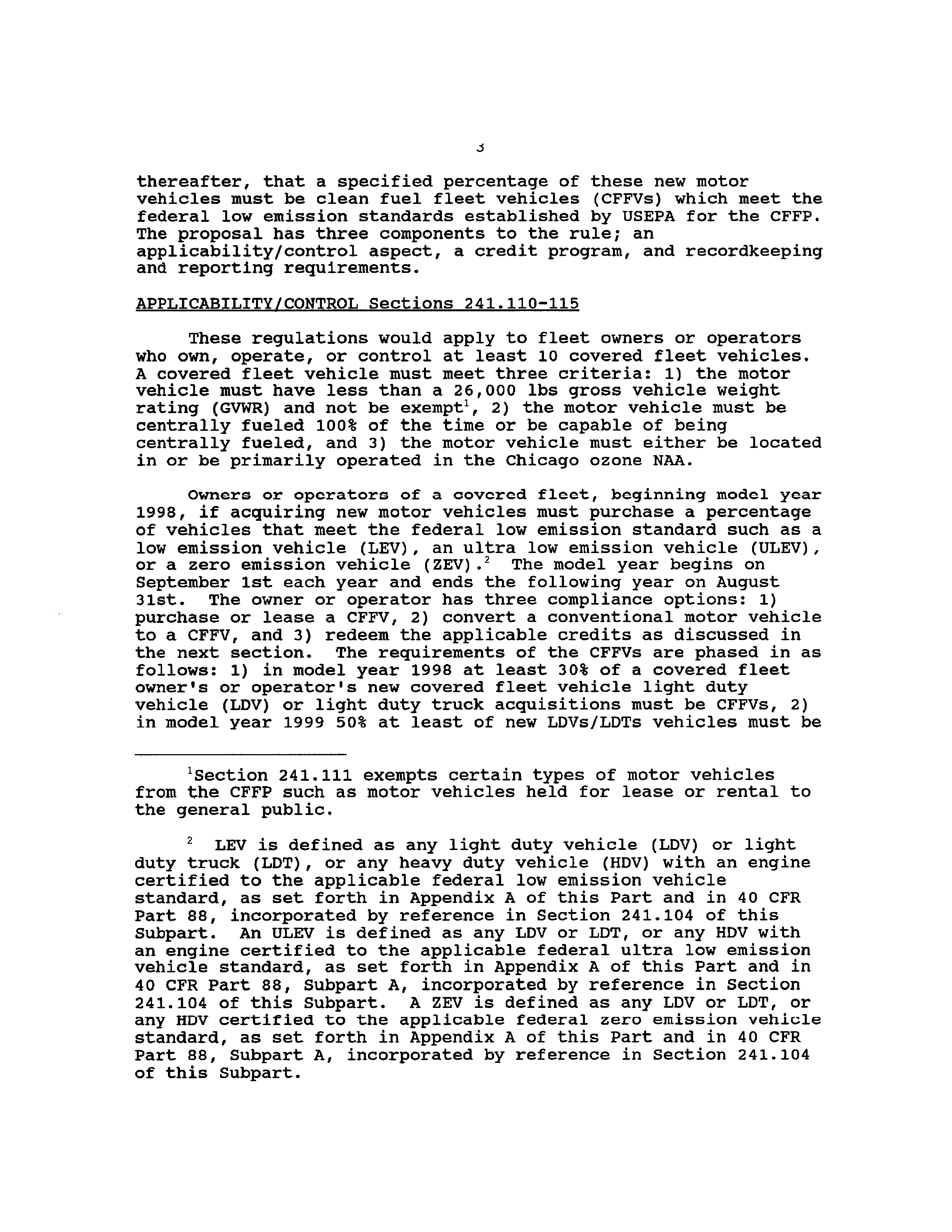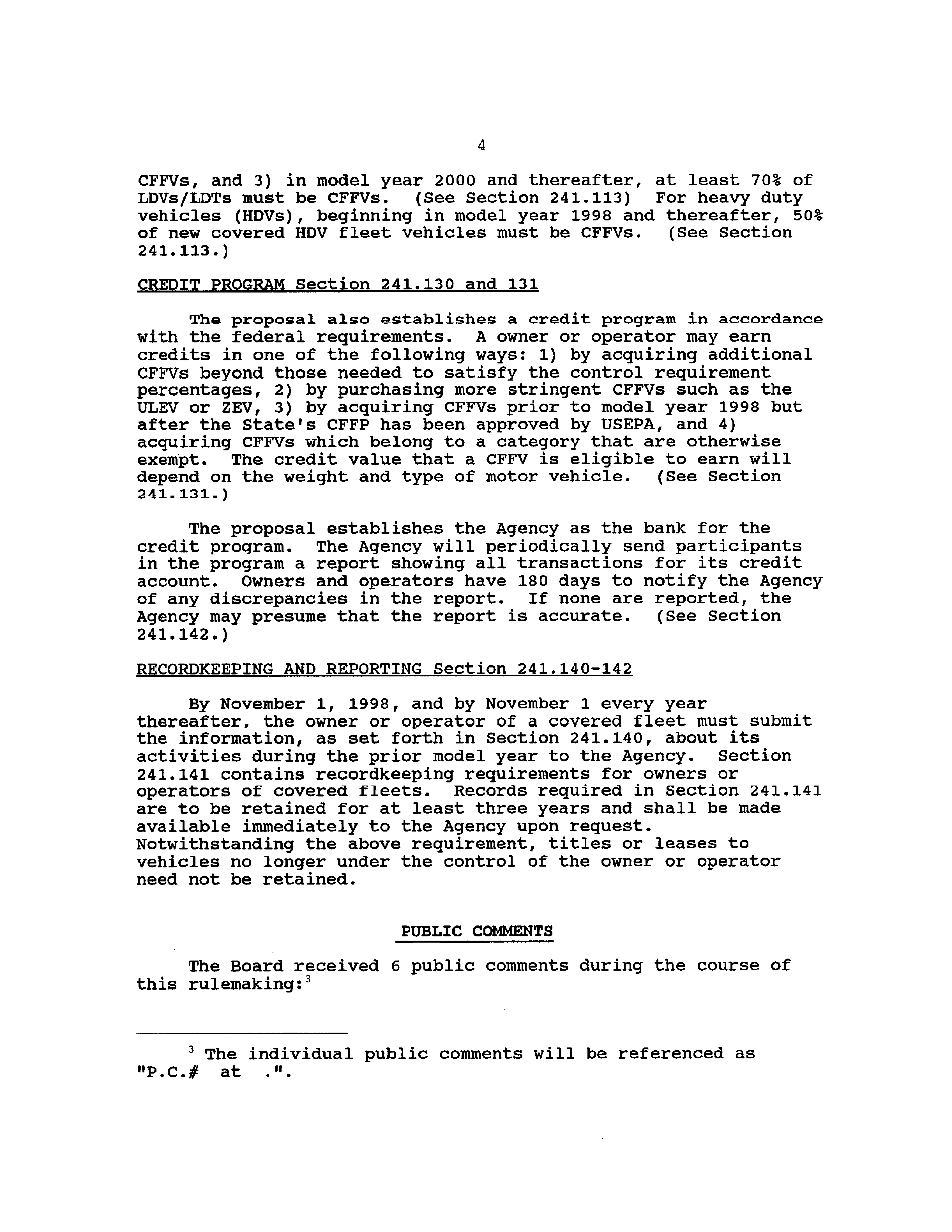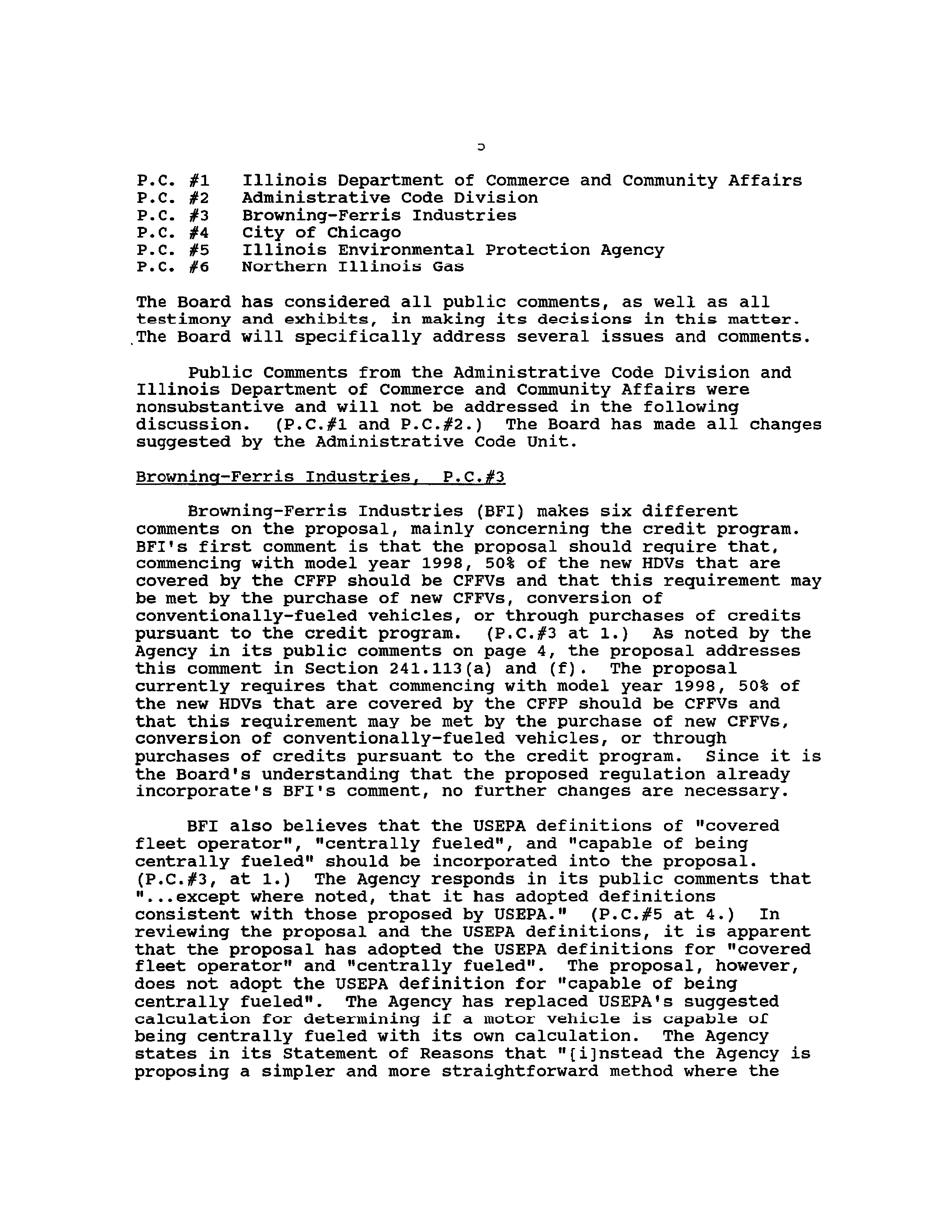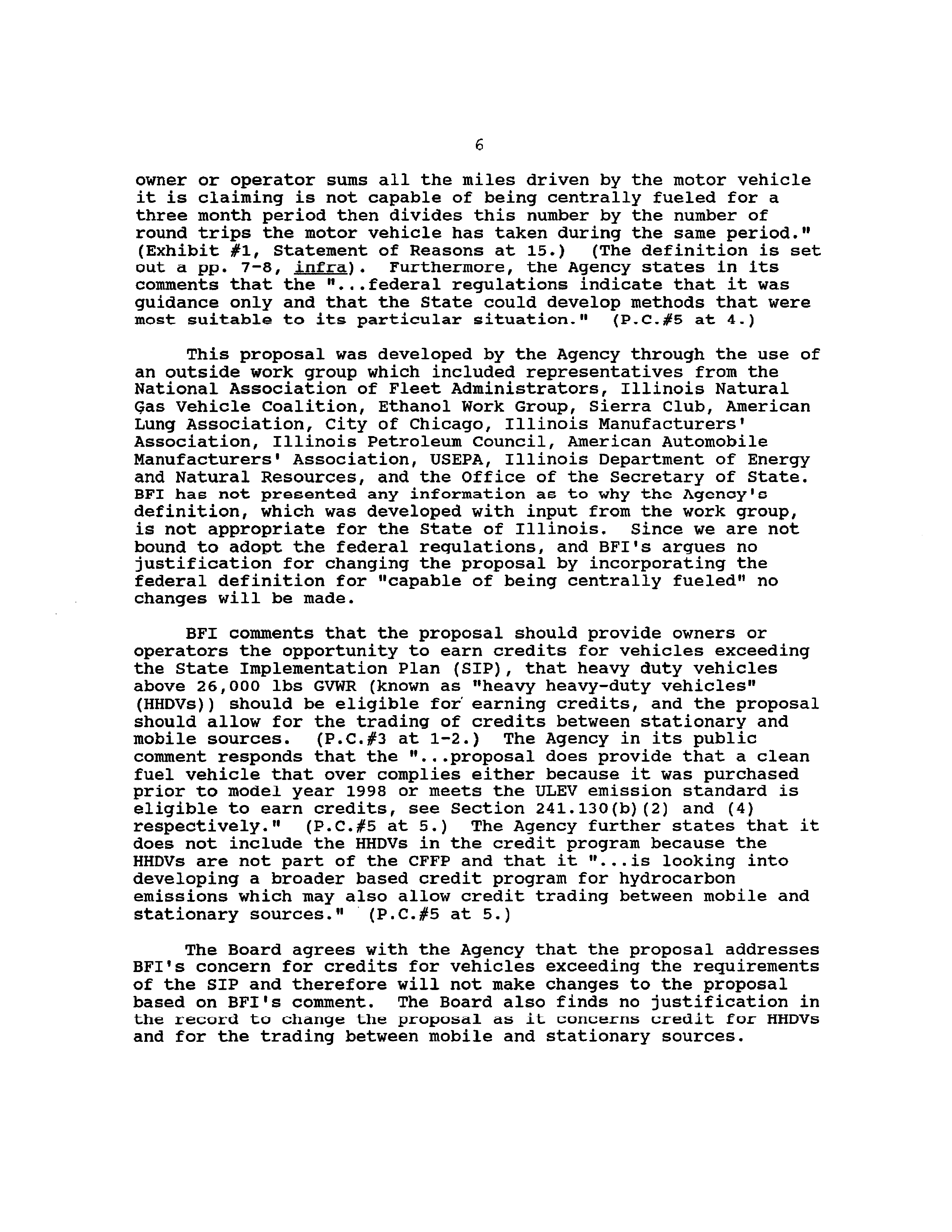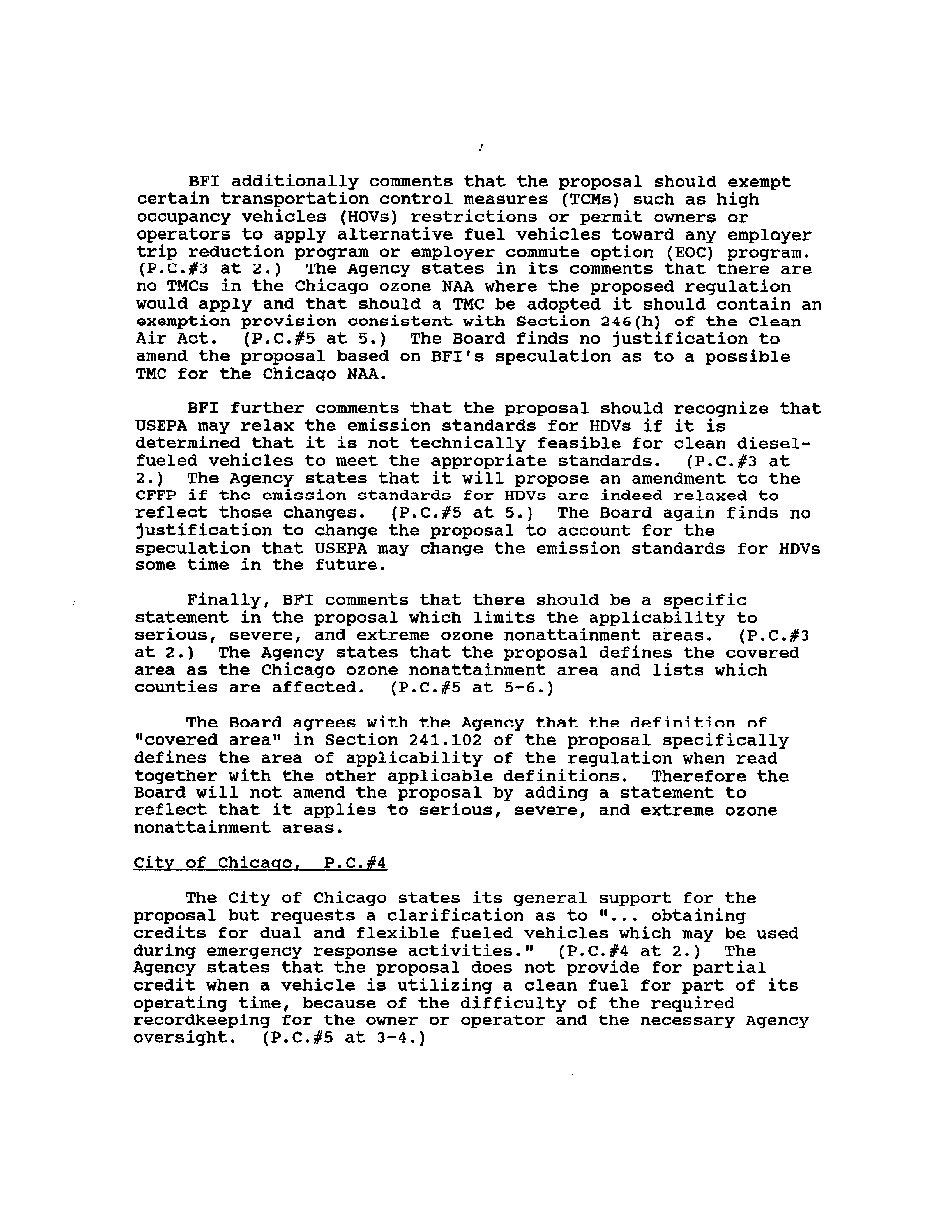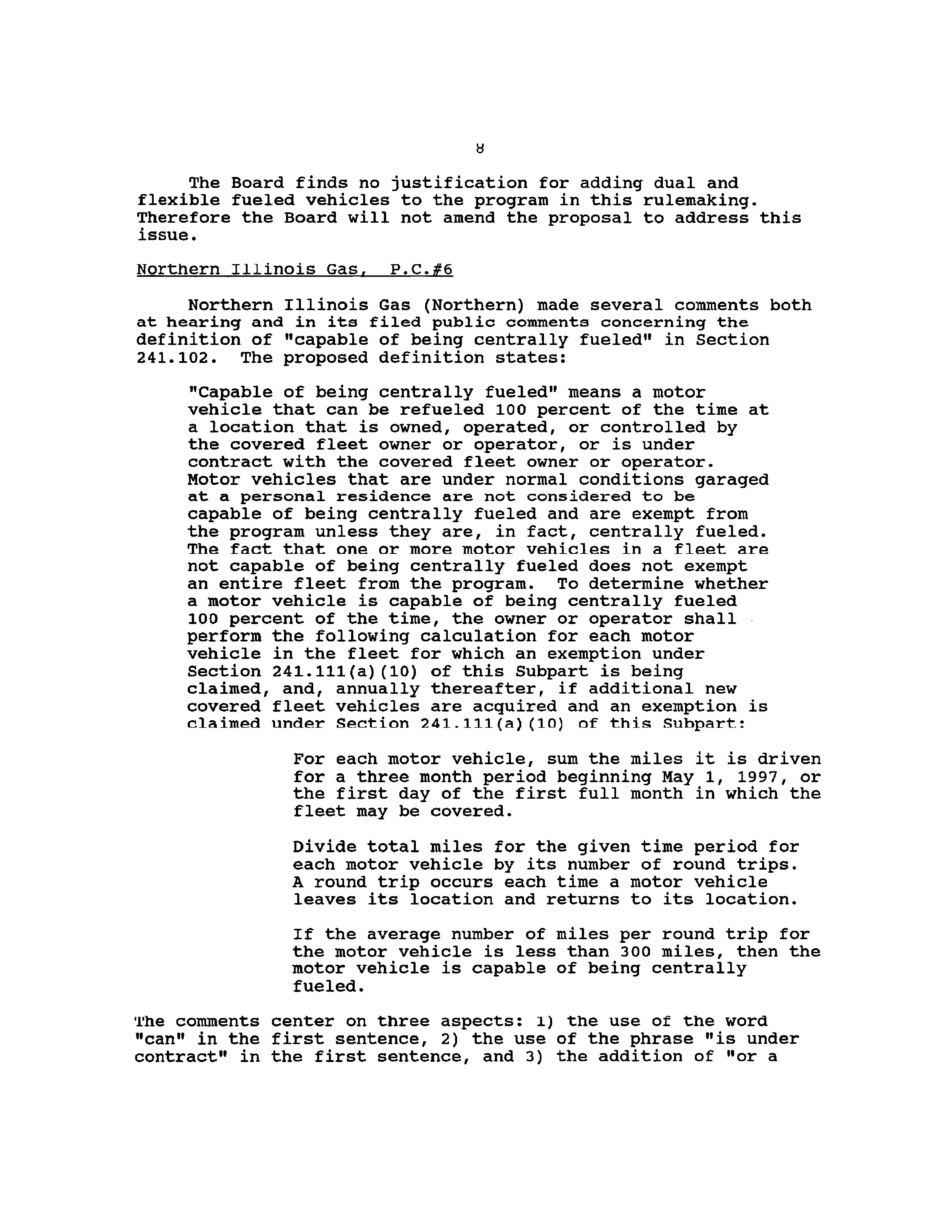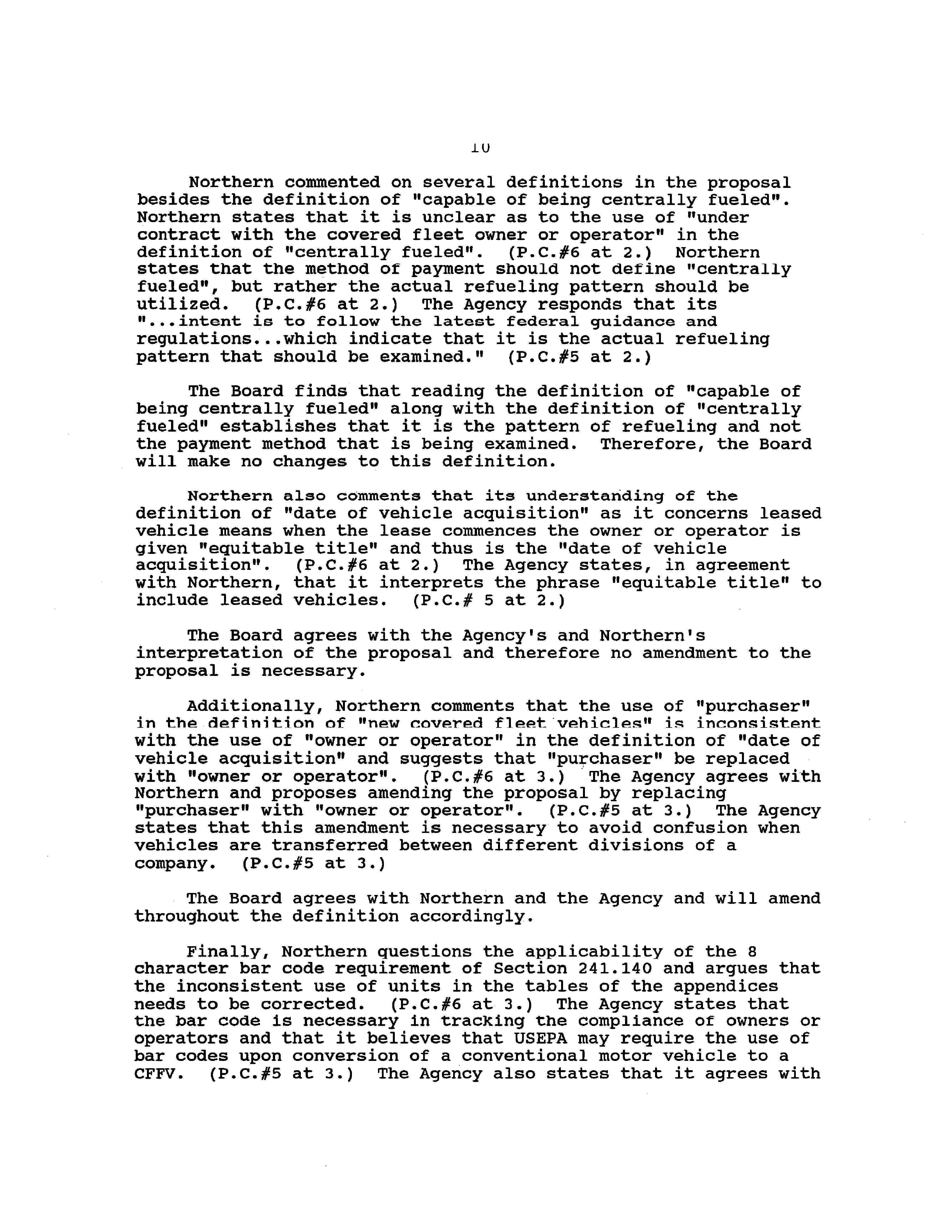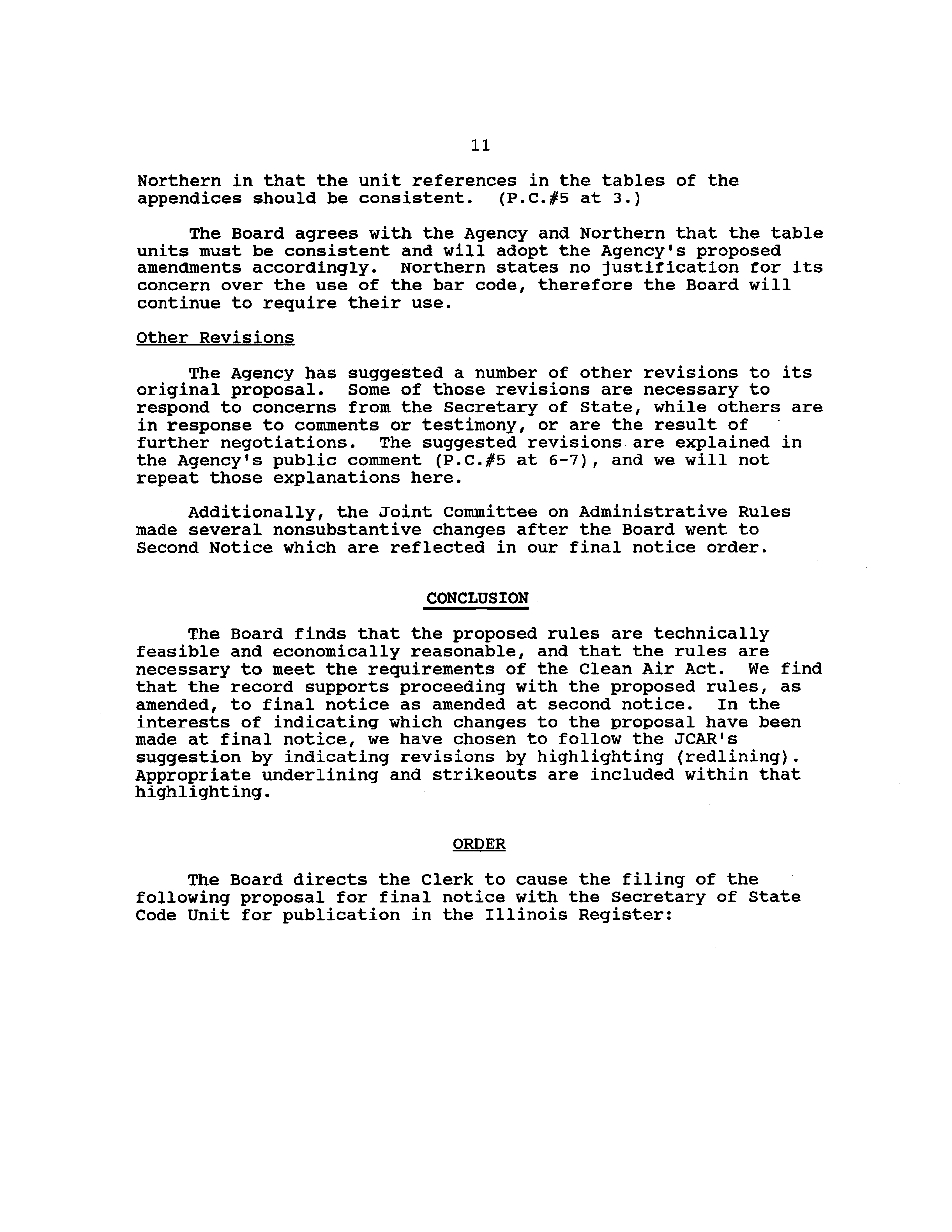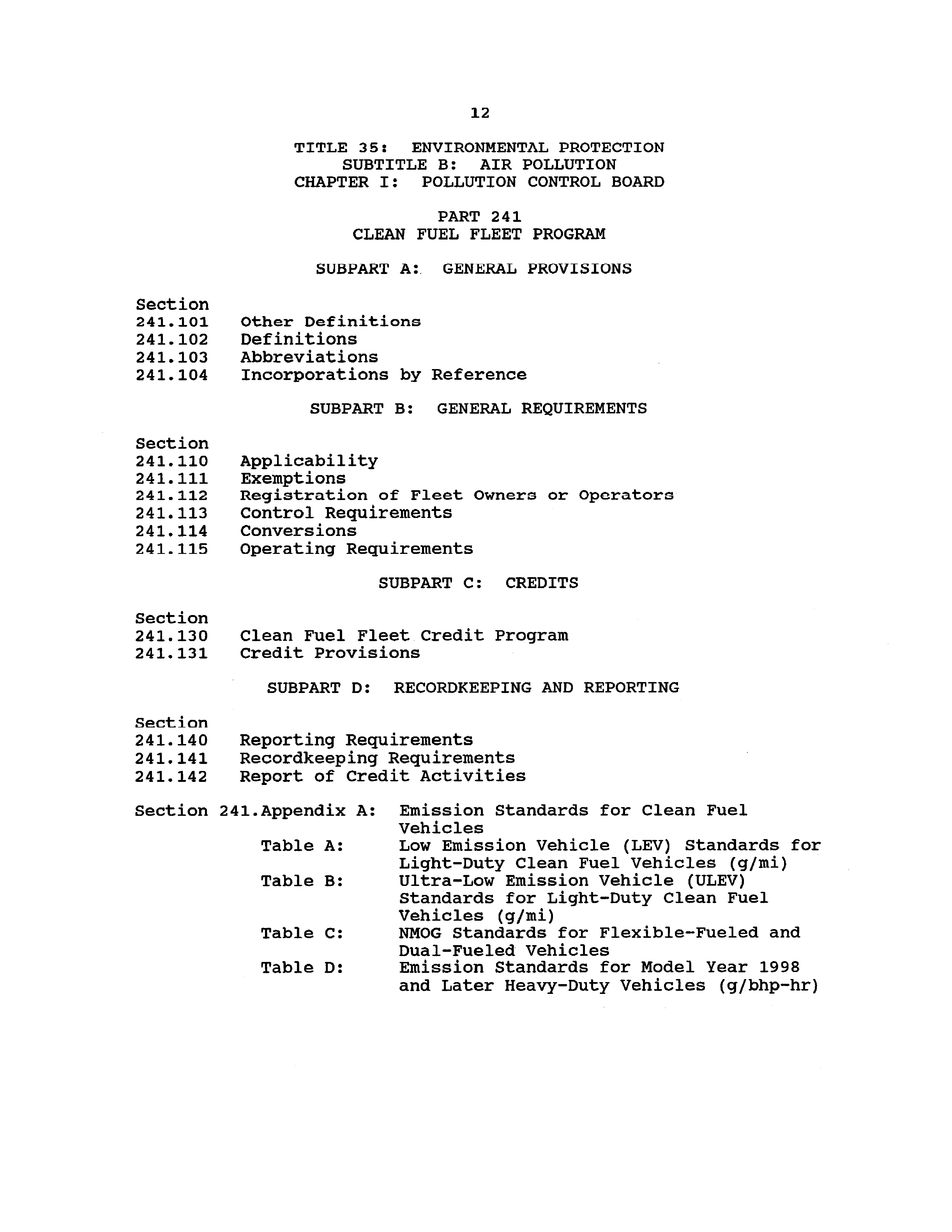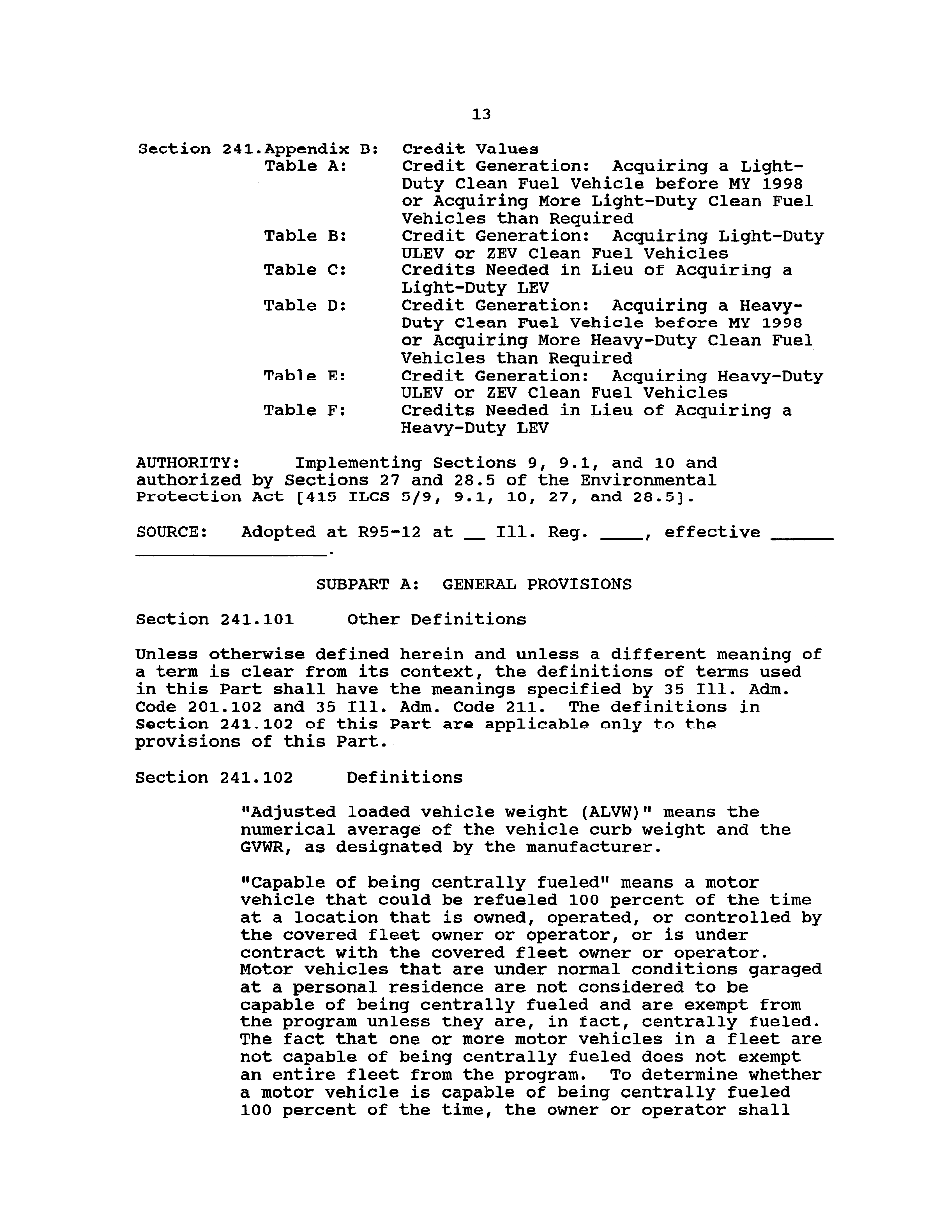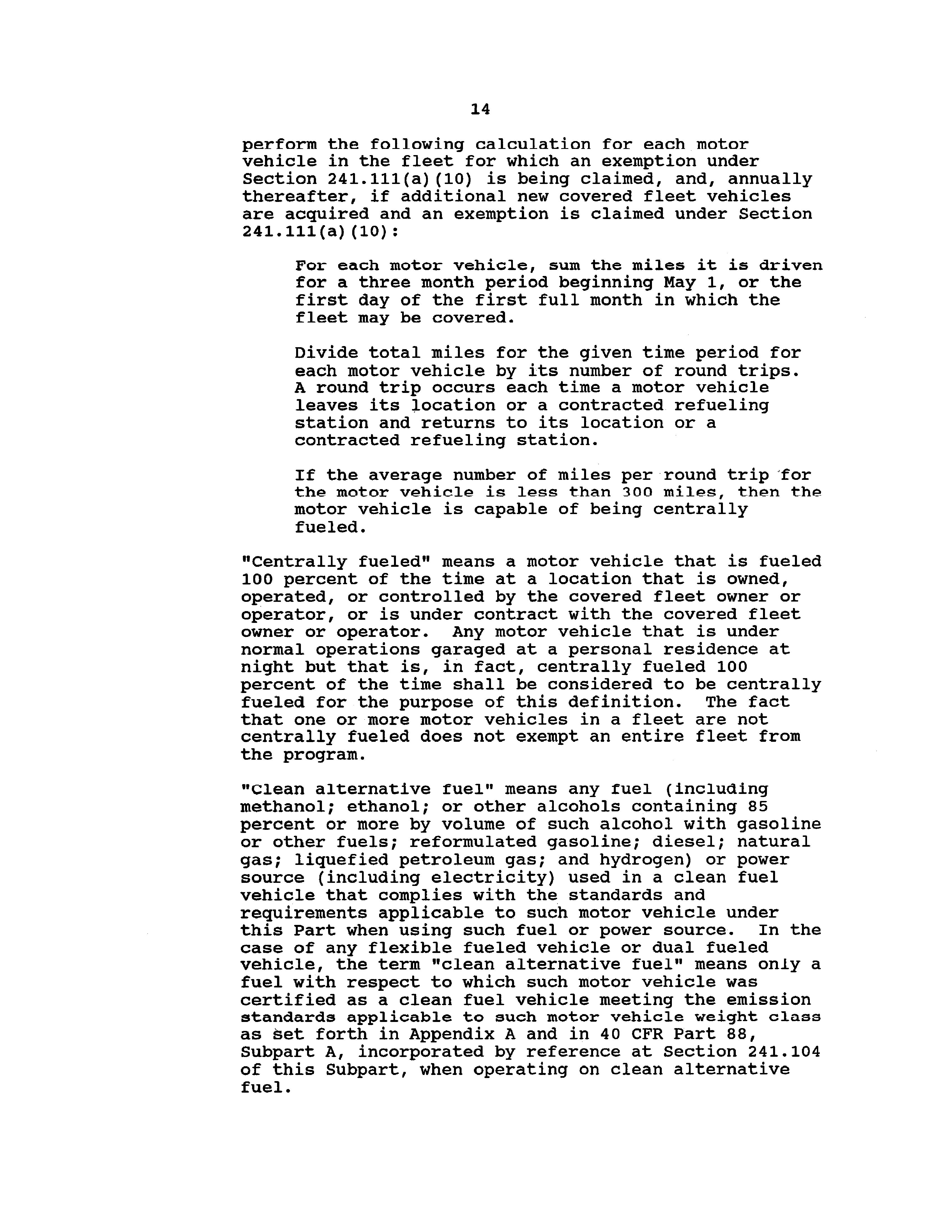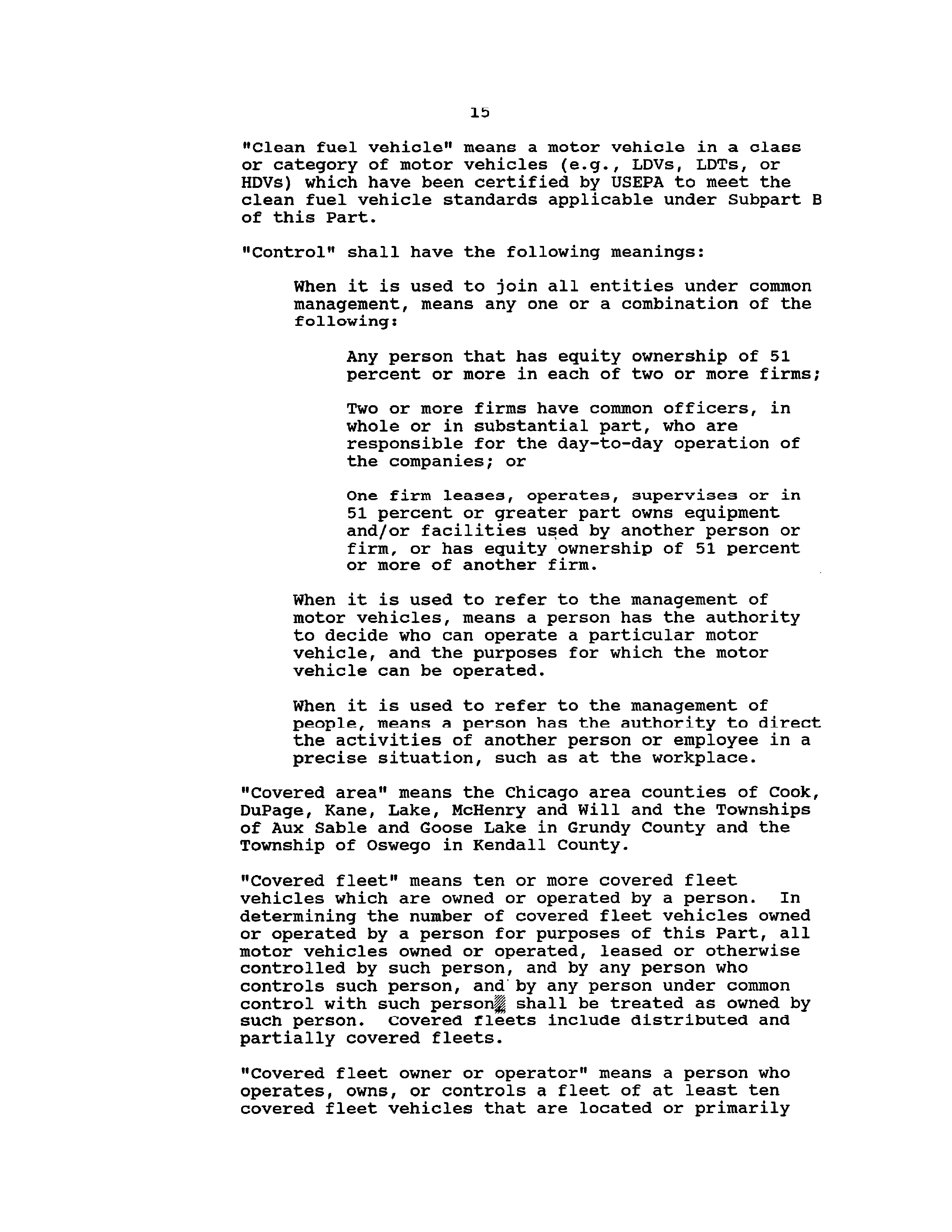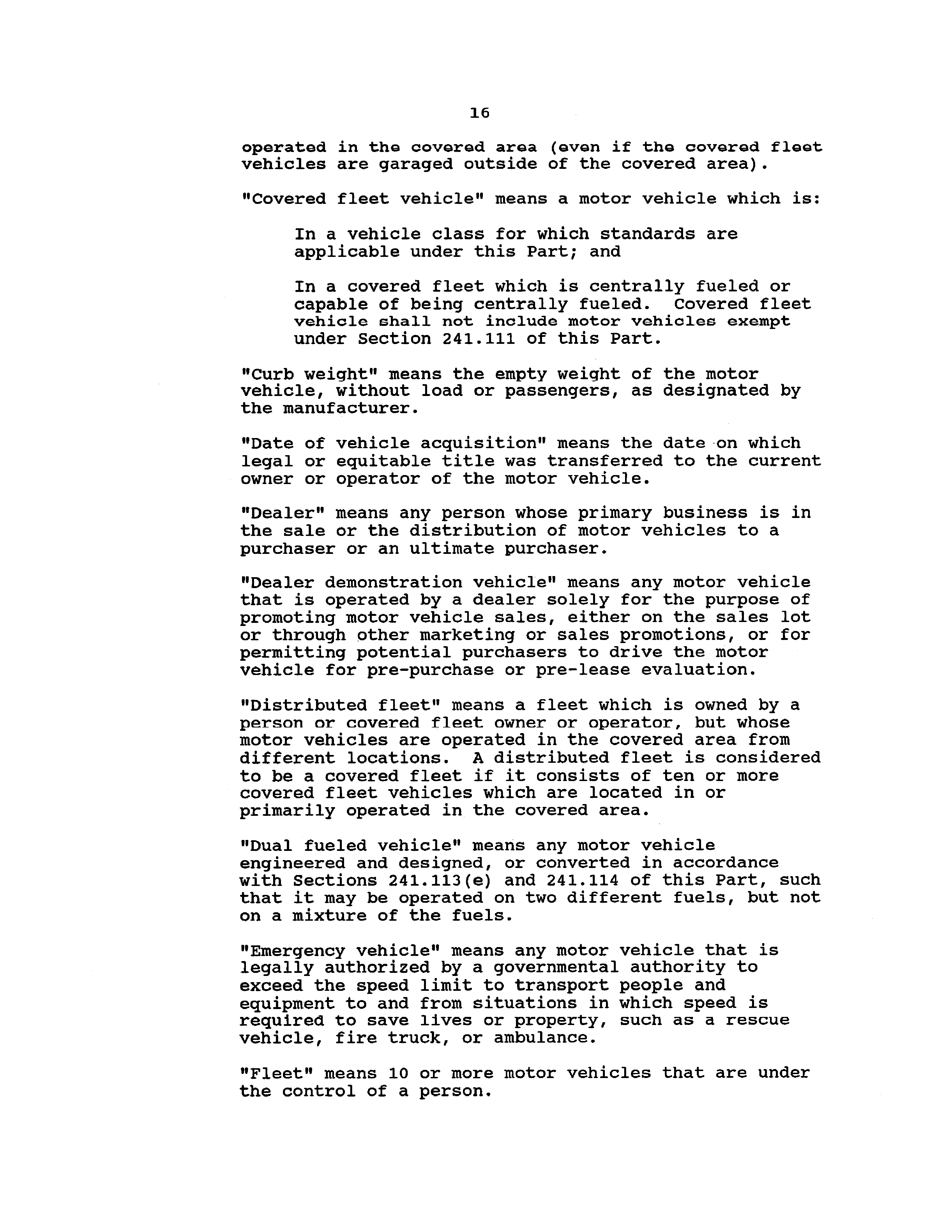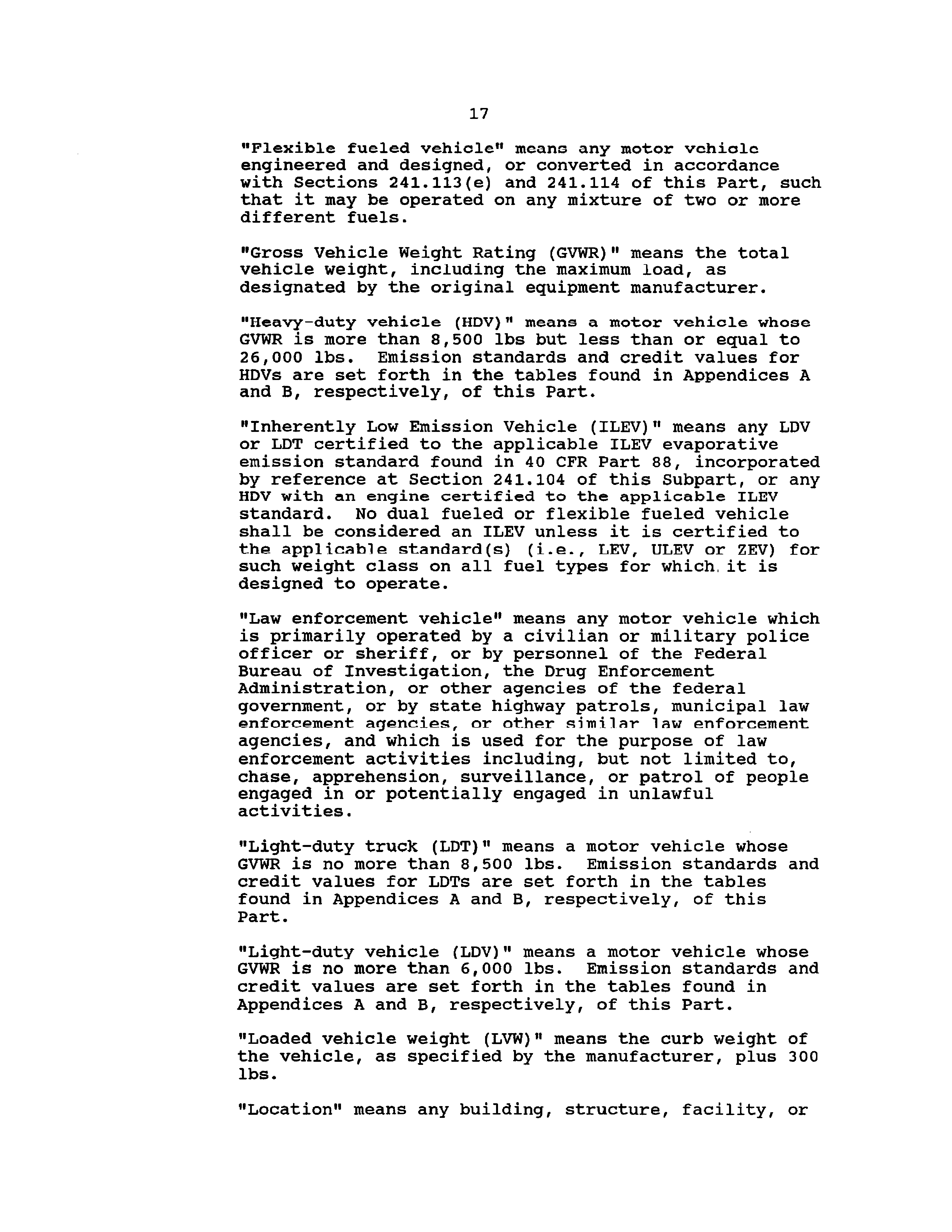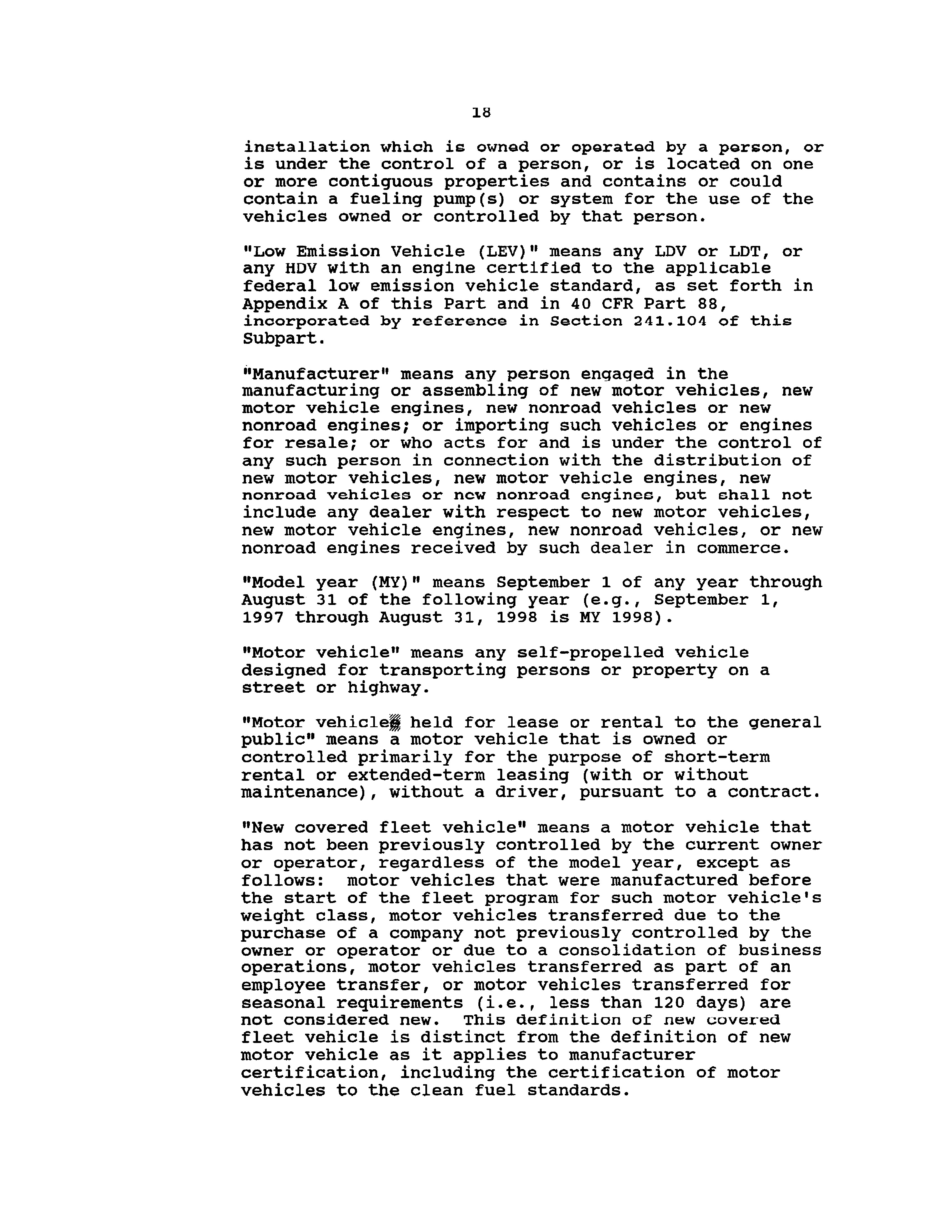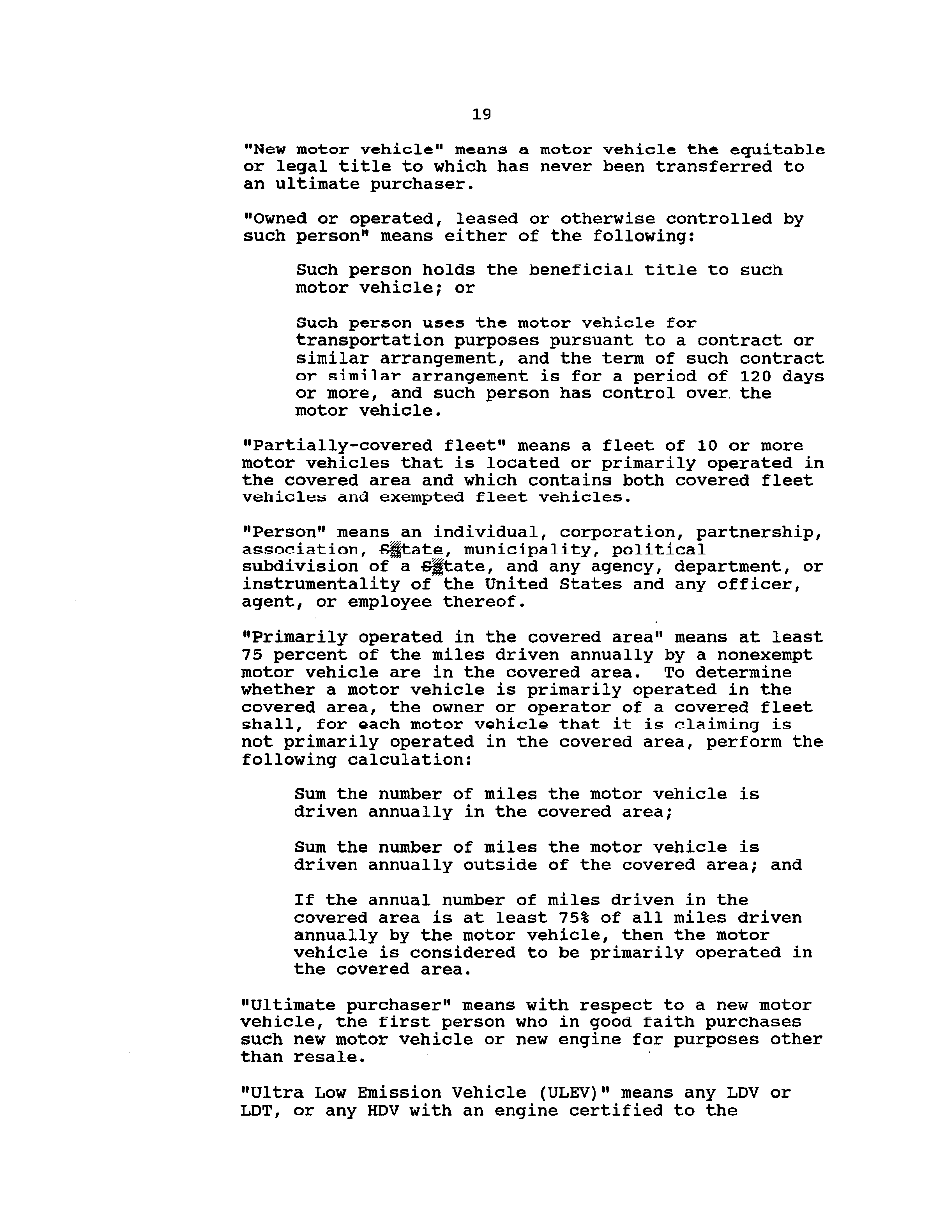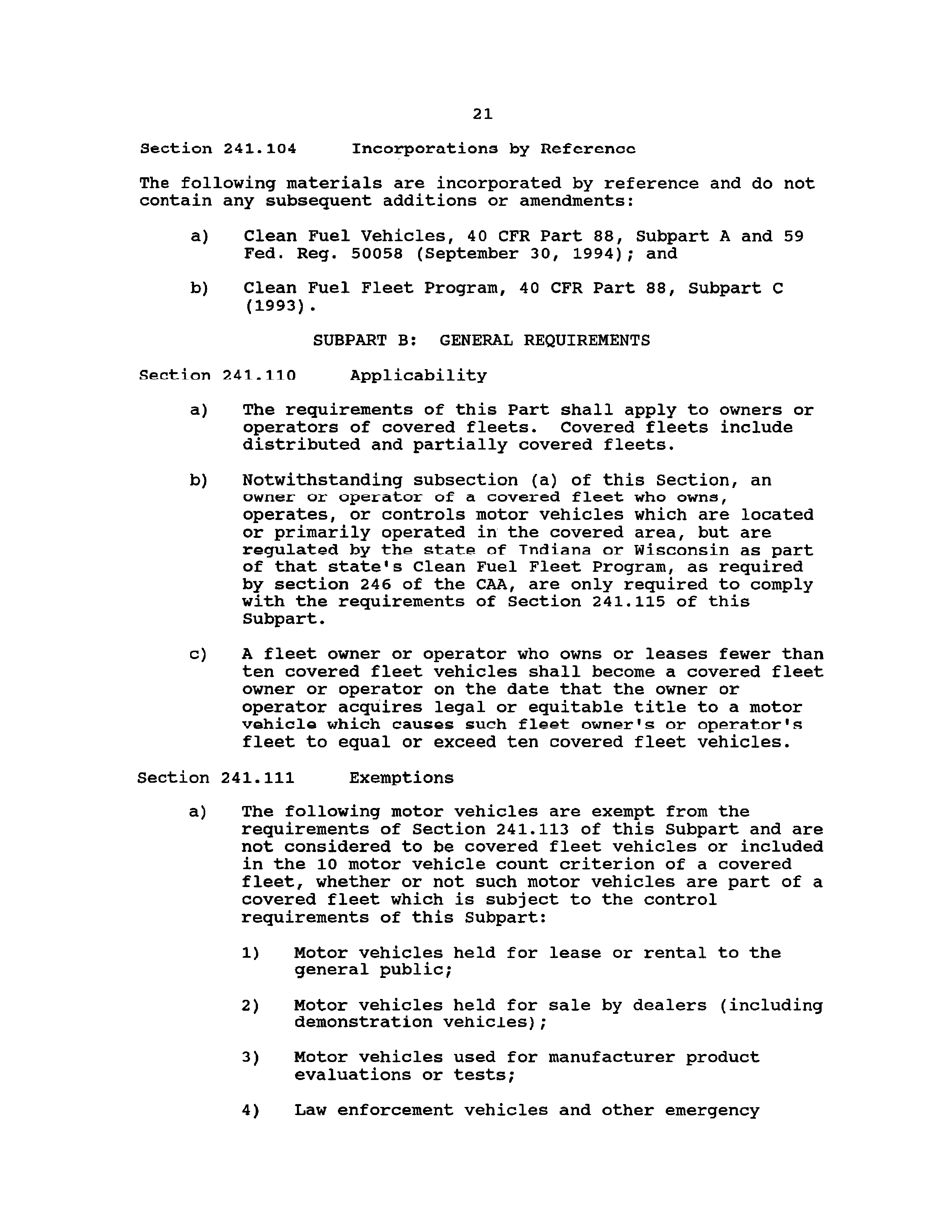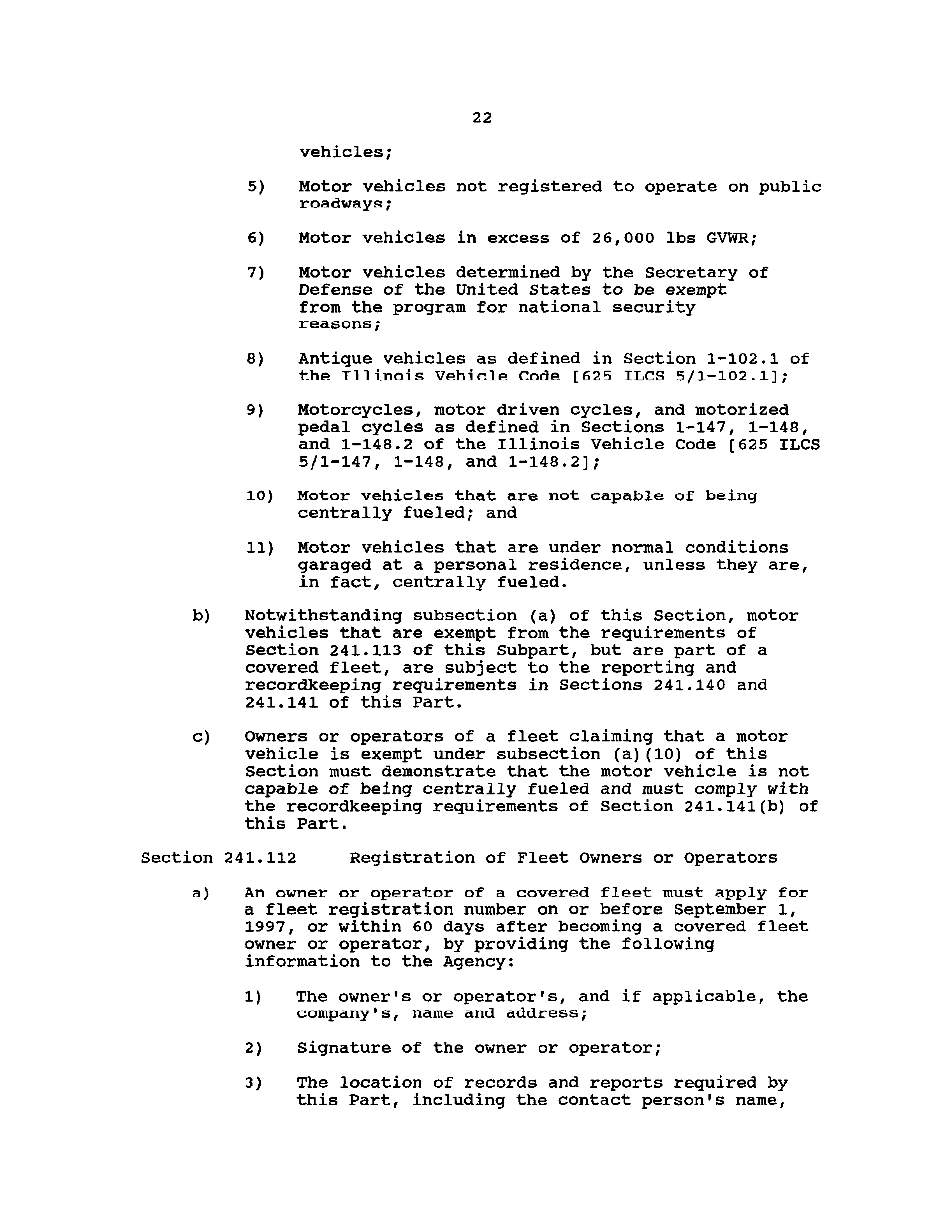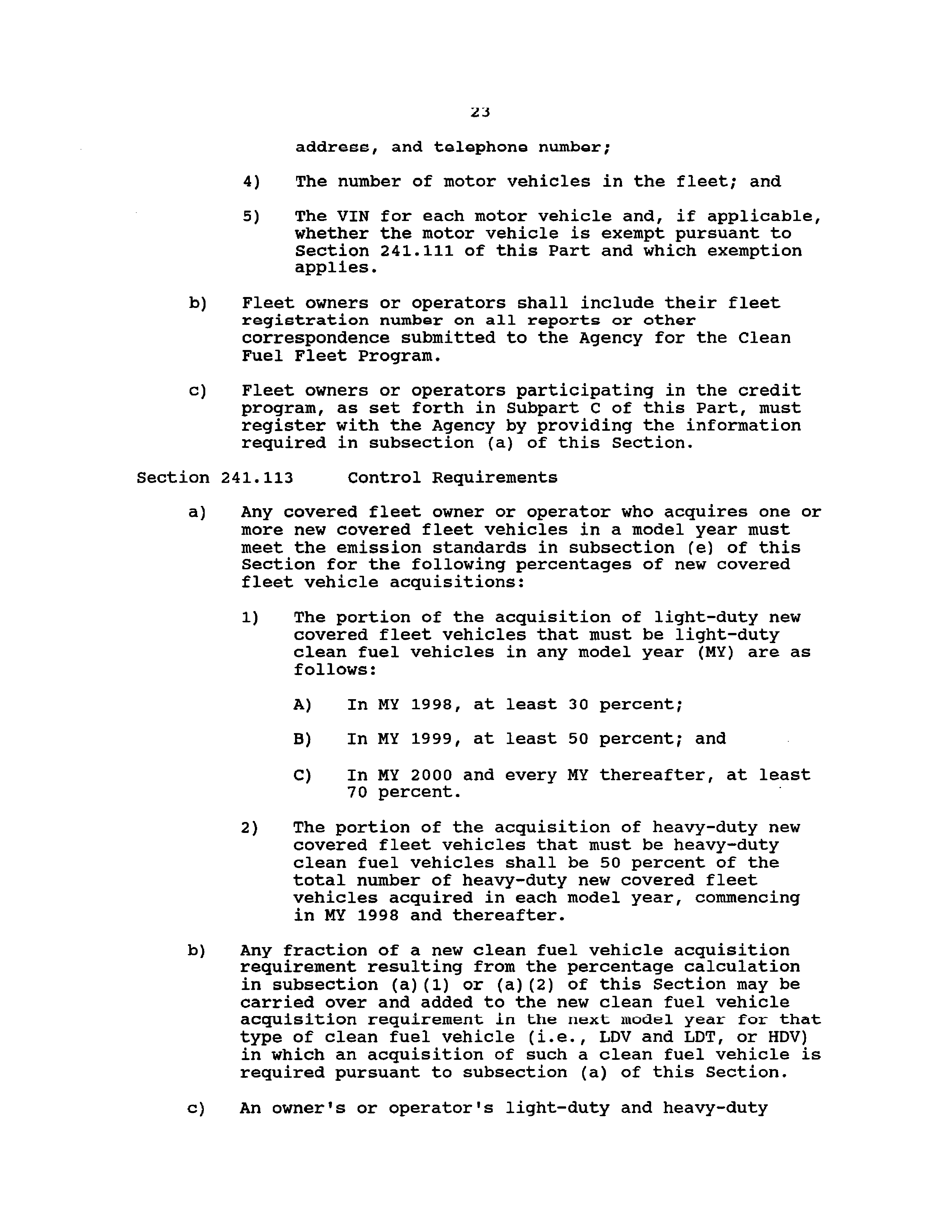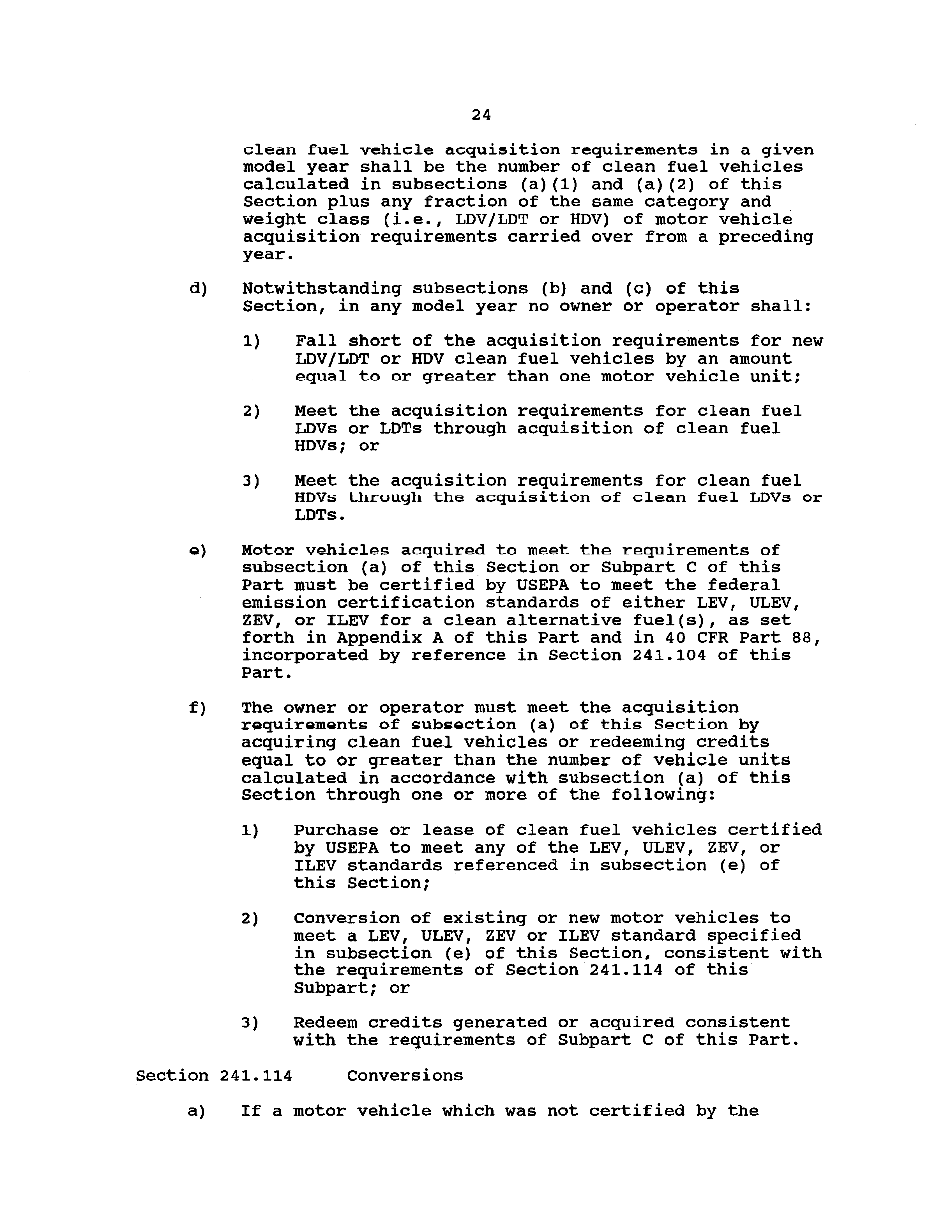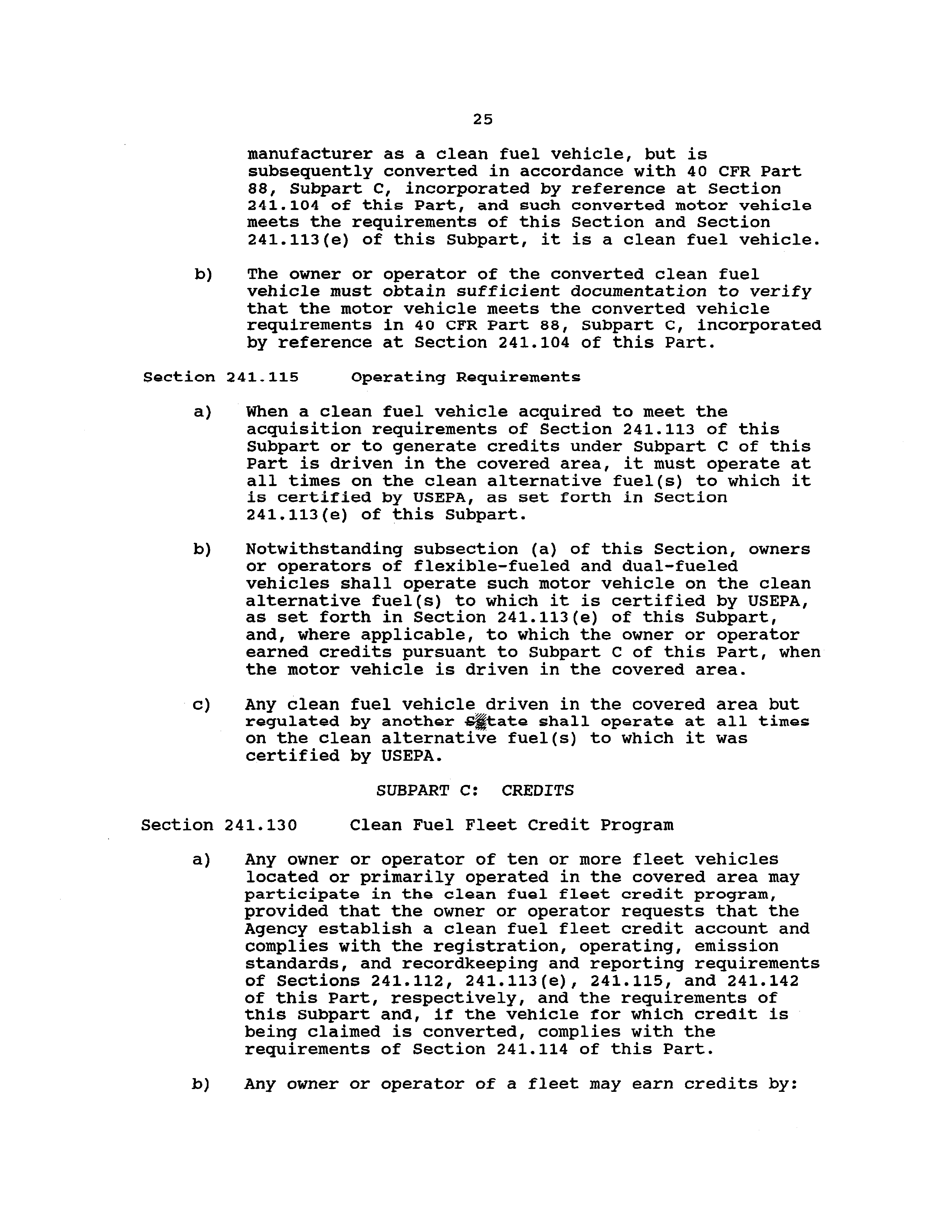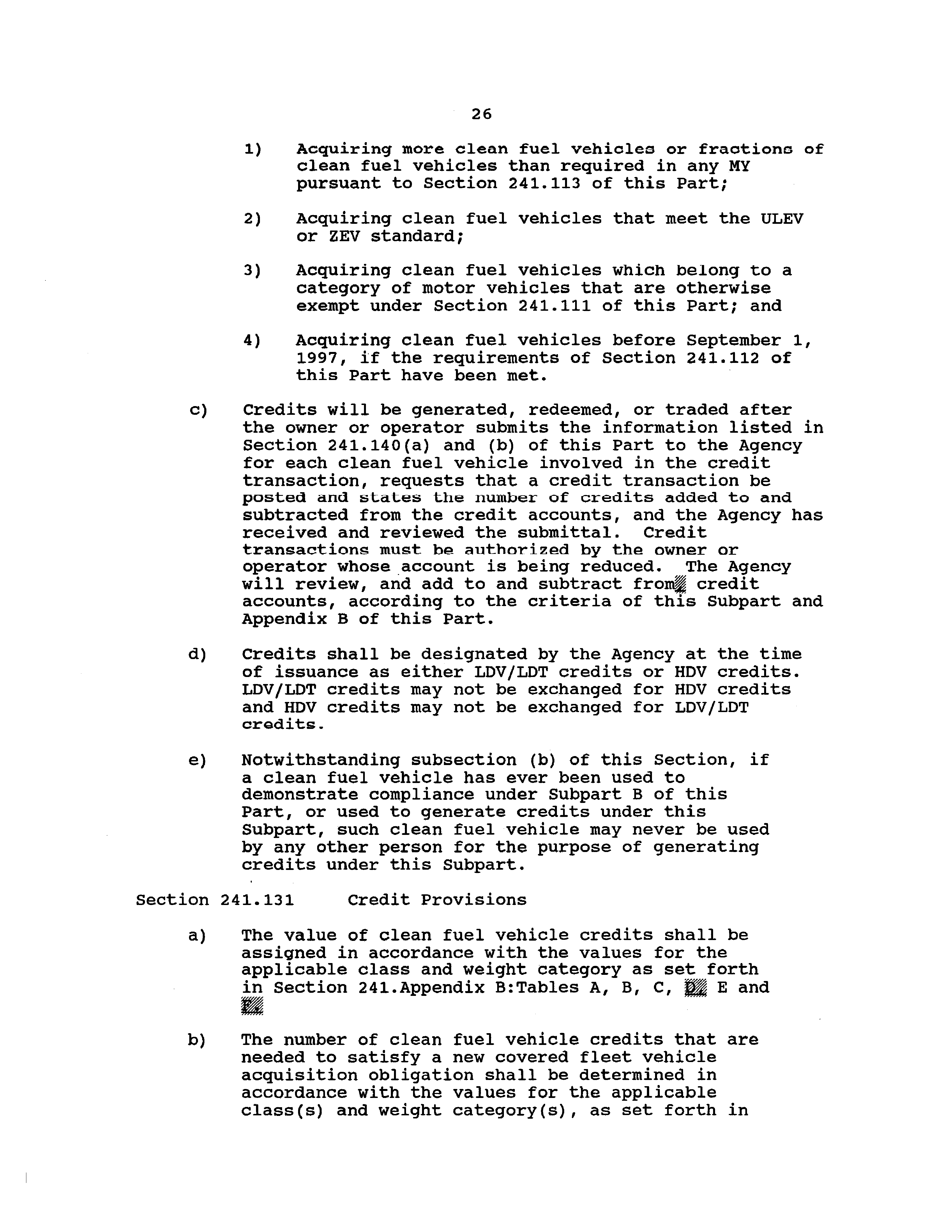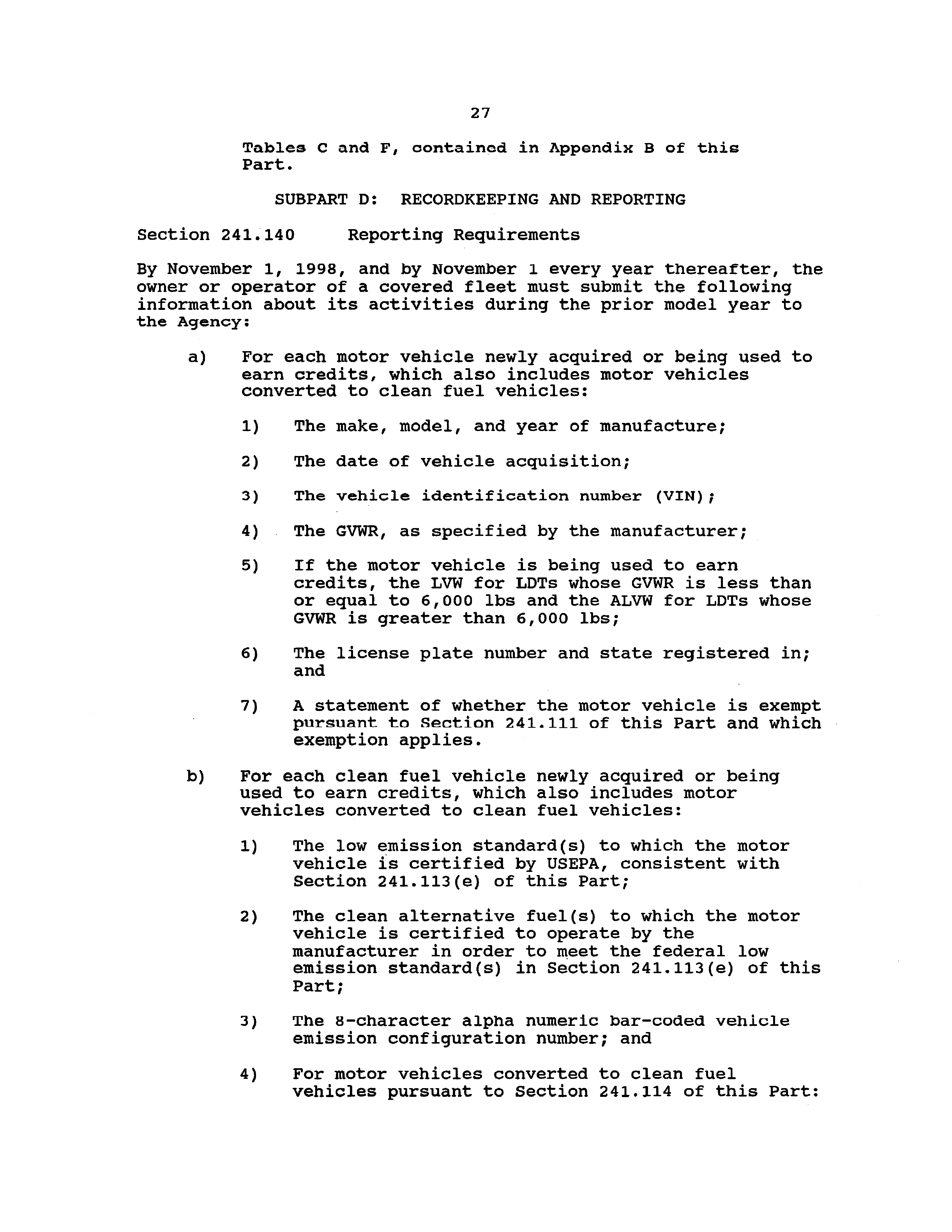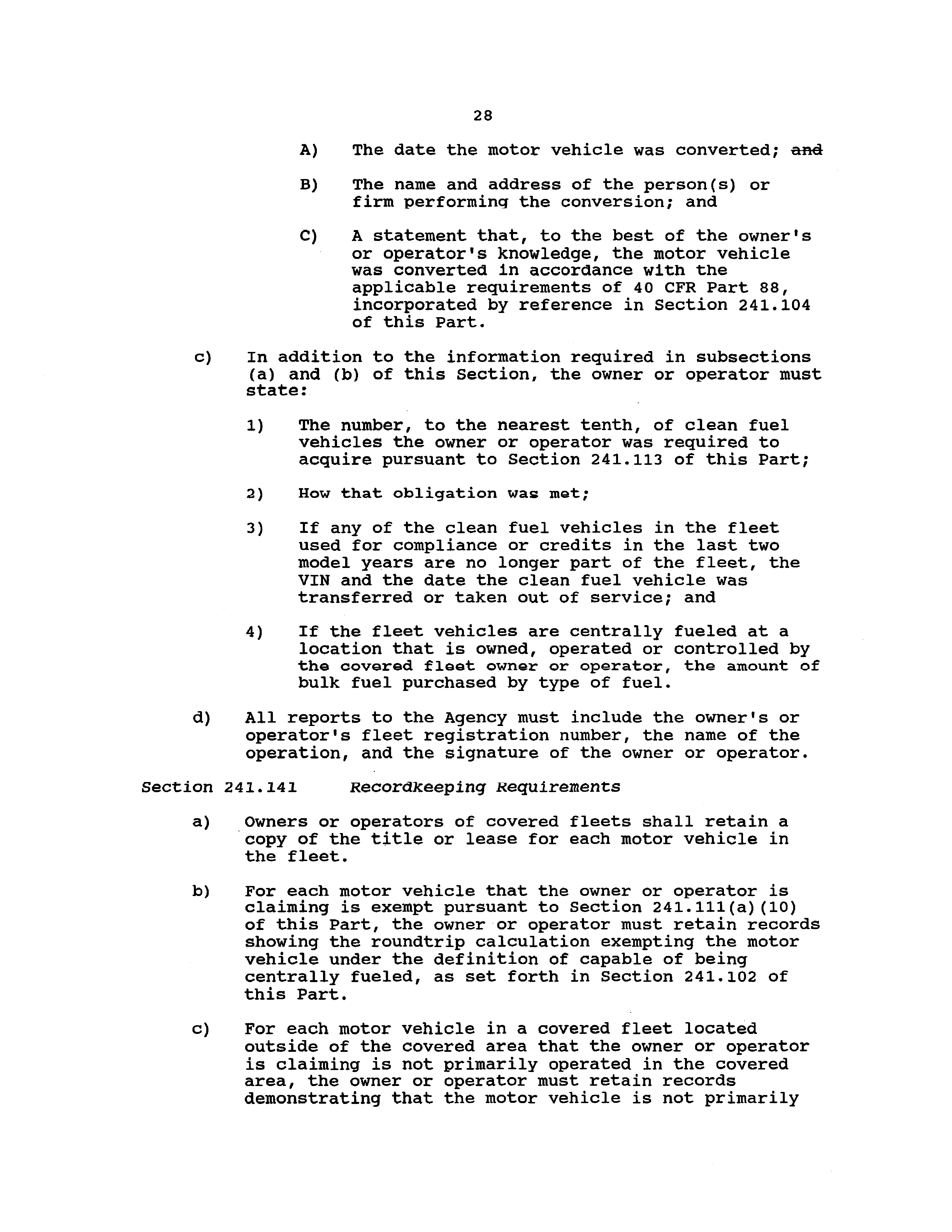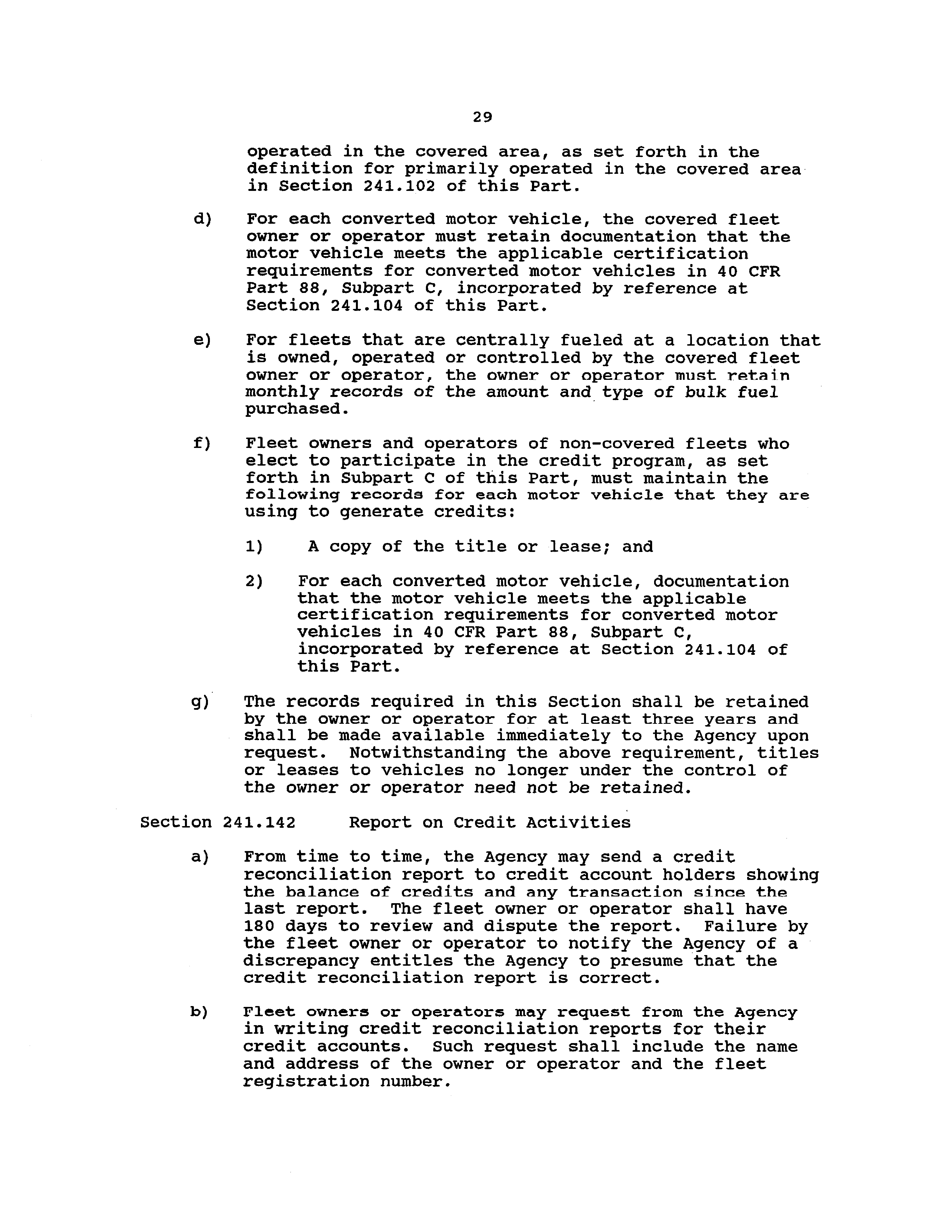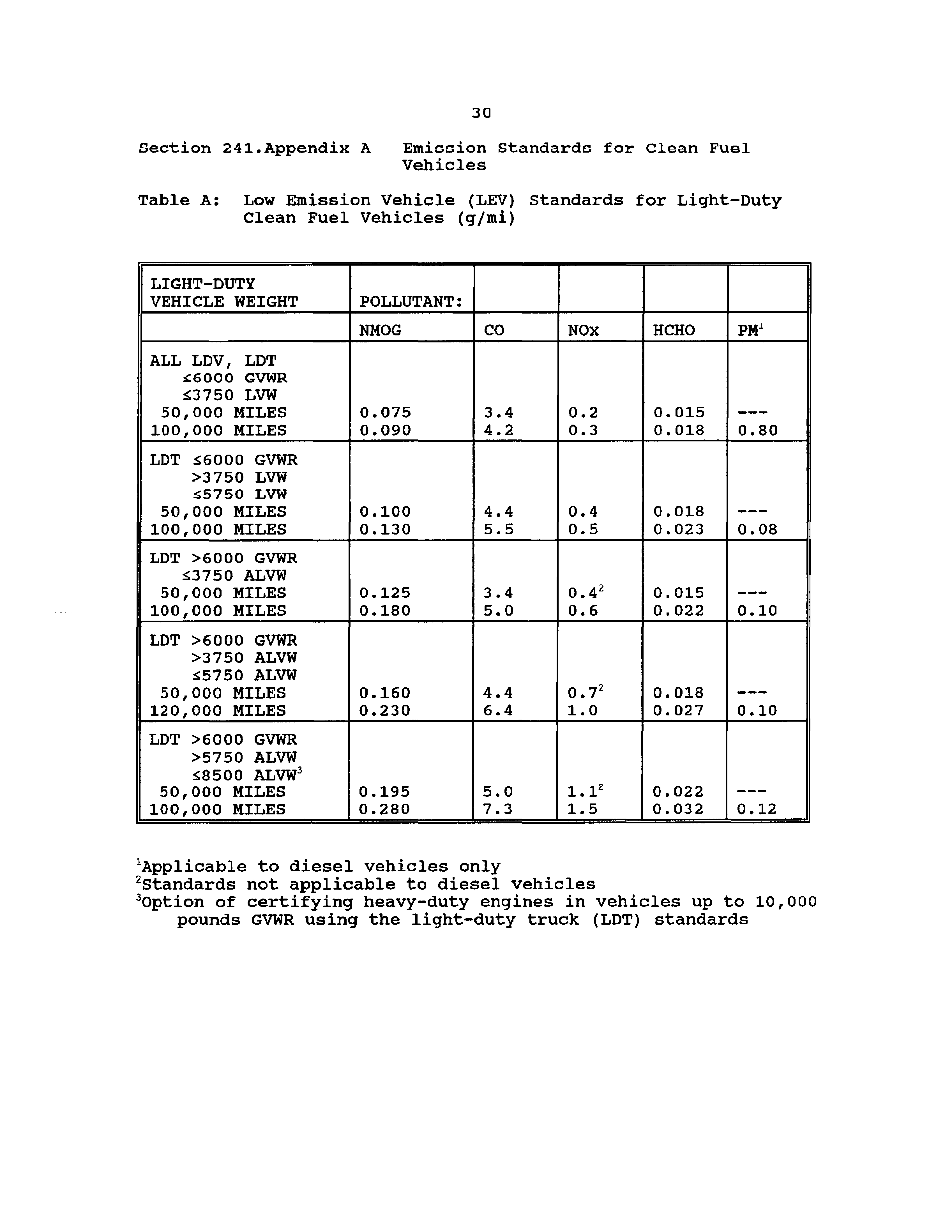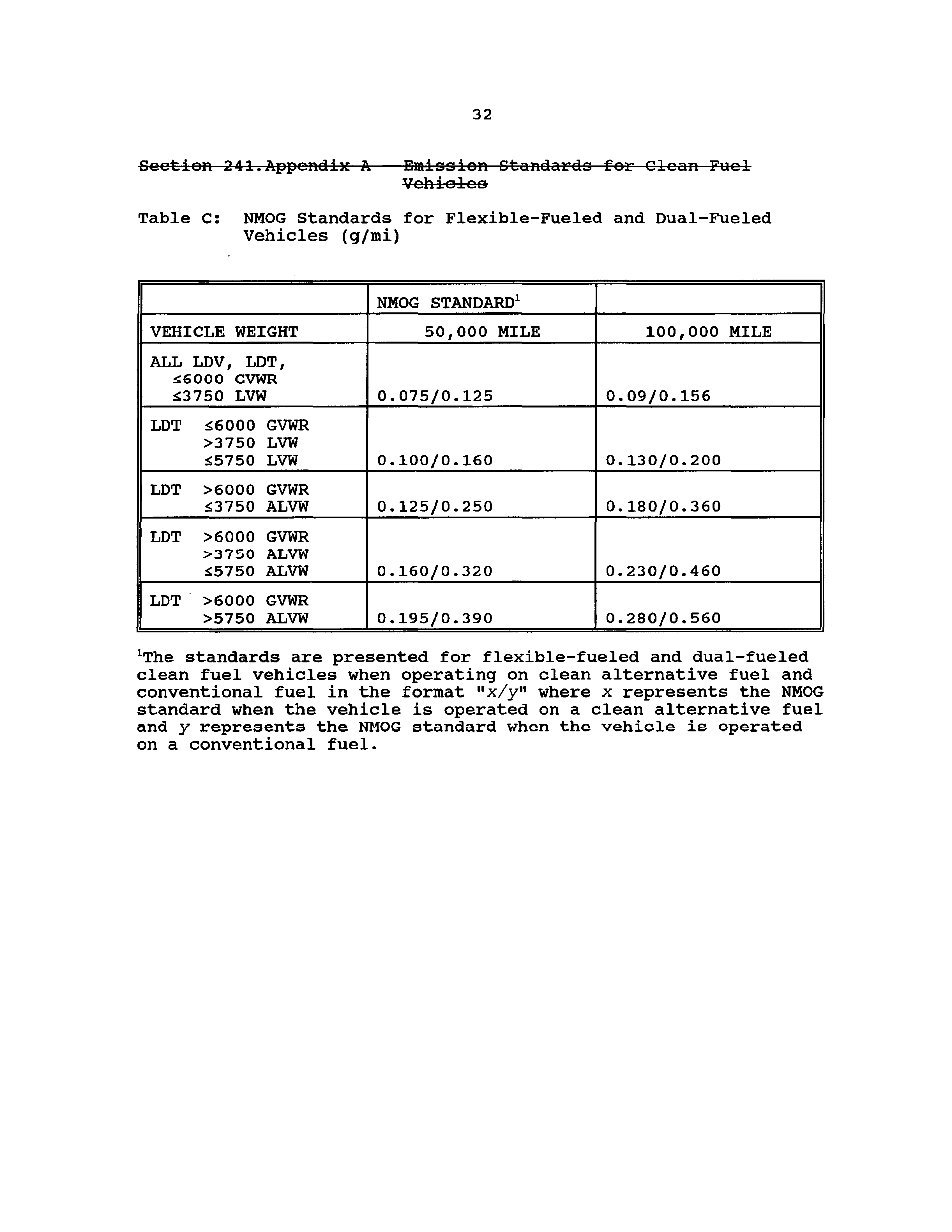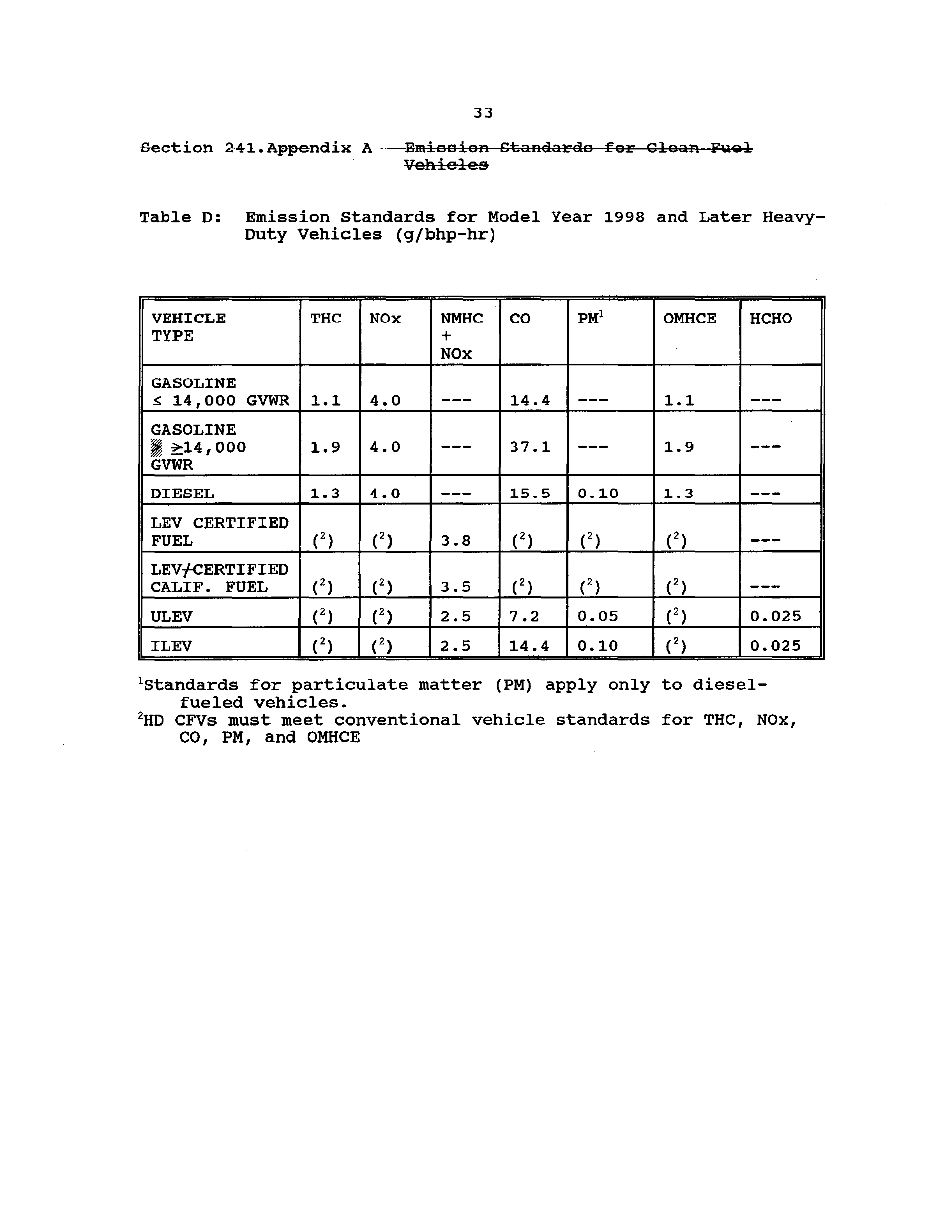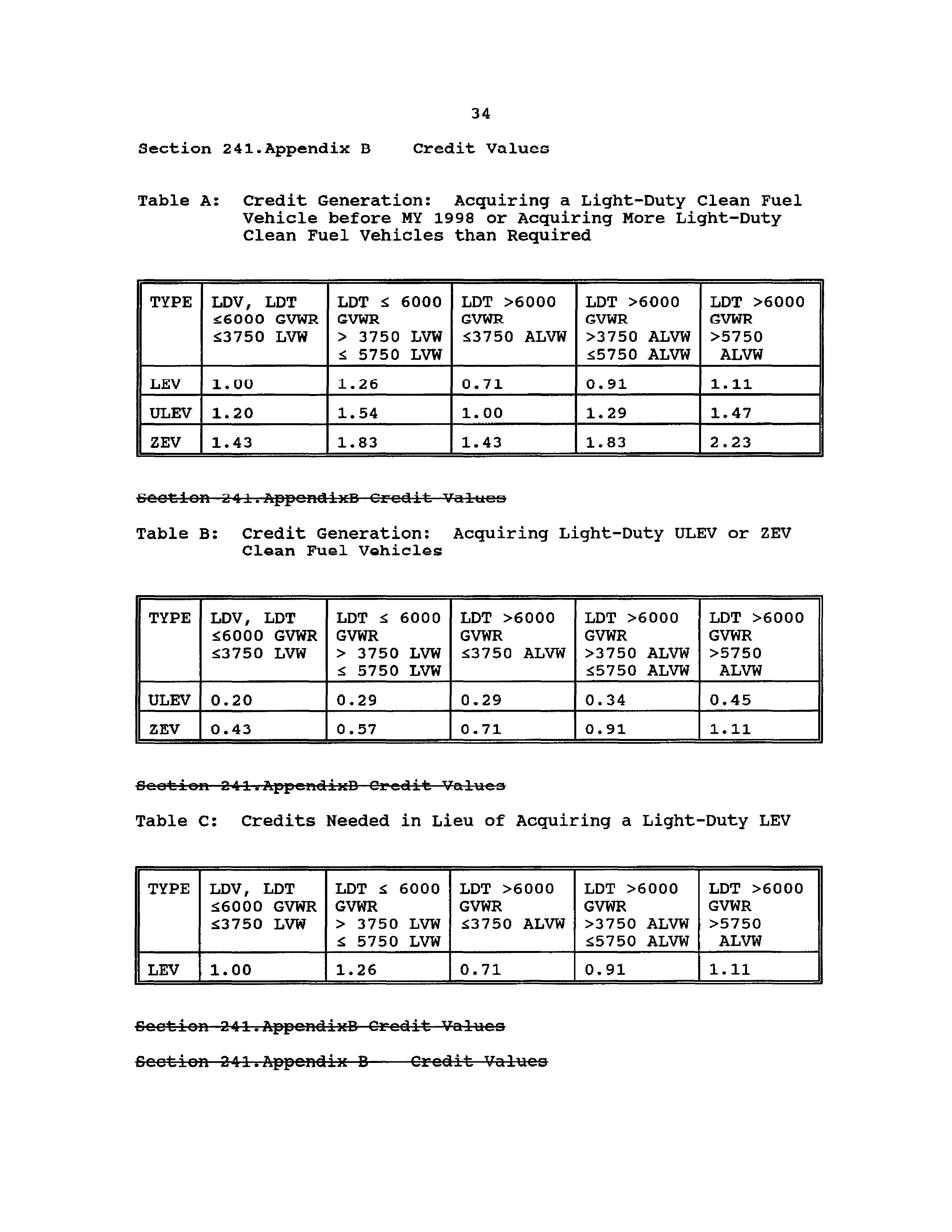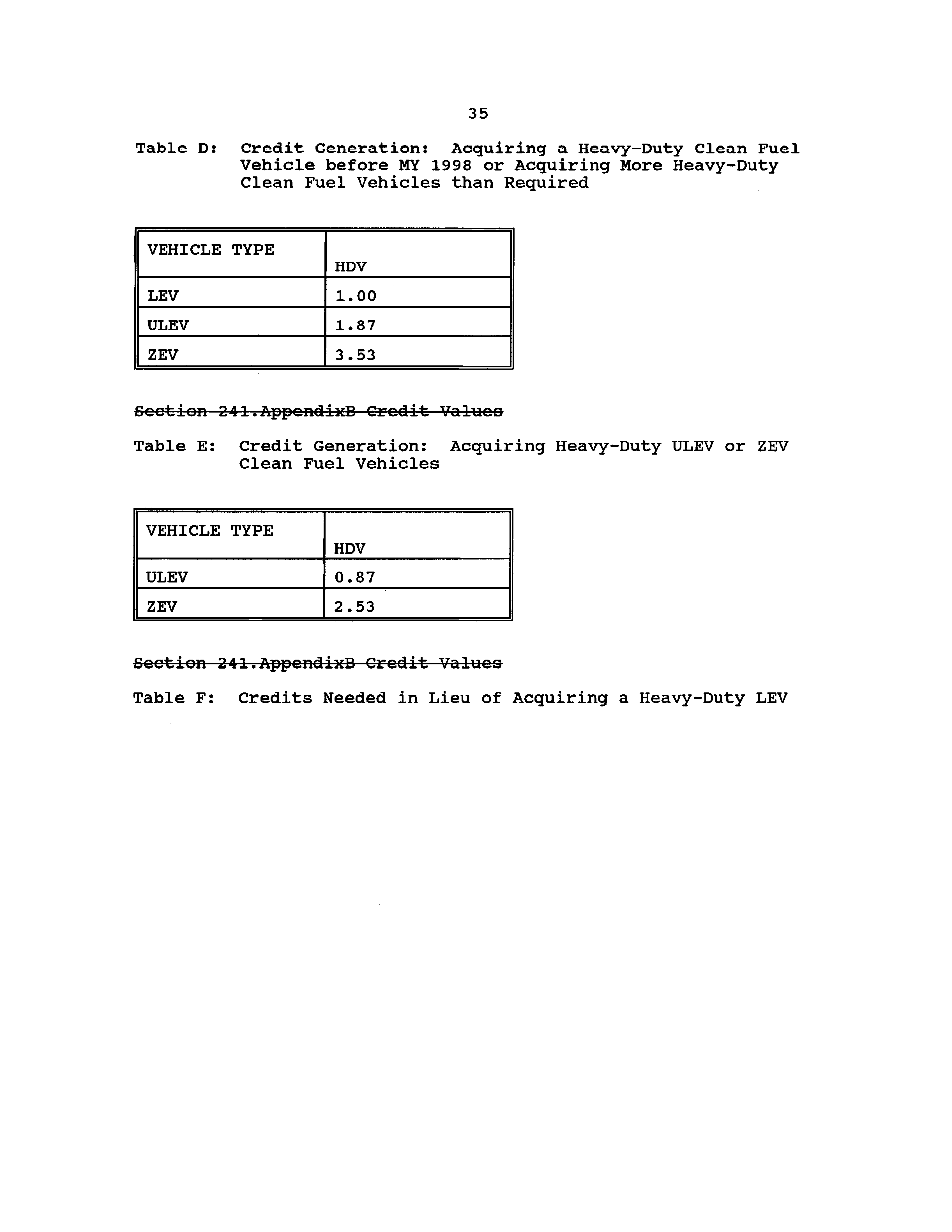ILLINOIS POLLUTION CONTROL BOARD
September
7,
1995
IN THE MATTER OF:
)
CLEAN FUEL FLEET PROGRAM:
)
R95-12
PROPOSED 35 ILL.
ADM. CODE 241
)
(Rulemaking—Air)
Adopted Rule.
Final Order.
OPINION
AND
ORDER OF THE BOARD
(by
.1. Yi):
On March 30, 1995 the Illinois Environmental Protection
Agency
(Agency) filed this proposal for rulemaking.
Sections
182(c) (4) (A) and 246 of the Clean Air Act (CAA)
(42 U.S.C §
7511(c)(4(A)
and §7586(199)), require all serious, severe, and
extreme ozone nonattainment areas
(NAA)
to adopt a clean-fuel
fleet
program
(CFFP)
by May 15,
1994.
In Illinois, the Chicago
area is classified as a severe
NAA
and is subject to the CFFP.
The attainment date for the Chicago area is 2007.
Pursuant to
CFFP,
if
Certain fleet owners acquire new motor vehicles,
beginning model year 1998 and thereafter,
a specified percentage
of these new motor vehicles must be clean fuel fleet vehicles
(CFFV5) which meet the federal low emission standards established
by the United States Environmental Protection Agency
(USEPA)
for
the CFFP.
The Board’s responsibility in this matter arises from the
Environmental Protection Act (Act).
(415 ILCS 5/1 et seq.
(1994).)
The Board is charged by the Act to “determine, define
and implement the environmental control standards applicable in
the State of Illinois.”
(415 ILCS 5/5(b)
(1994).)
More
generally, the Board’s rulemaking charge is based on the system
of checks and balances integral to Illinois environmental
governance: the Board bears responsibility for the rulemaking and
principal adjudicatory functions, while the Agency is responsible
for carrying out the principal administrative duties.
The
Agency’s duties include administering the regulations that are
proposed in this rulemaking.
This proposal was filed pursuant to Section 28.5 of the Act.
(415 ILCS 5/28.5
(1994).)
That section requires the Board to
proceed with
CAA
rulemaking under set time-frames, and is known
as “fast—track” rulemaking.
The Board has no discretion to
adjust these time frames under any circumstances.
Today the
Board acts to send this proposal to final notice under the
Illinois Administrative Procedure Act
(APA).
(5 ILCS 100/1005-40
(1994).)
PROCEDURAL HISTORY
On April
6,
1995,
the Board sent the proposal to first
notice under the APA, without commenting on the merits of the
proposal.
The proposal was published in the Illinois Register on
April 28,
1995,
at Volume 19 Issue 17 Ill.Reg. pg.
6101.
Hearing
was held on May 19,
1995,
in Chicago,
Illinois.
Members of the
public attended that hearing,
as well as representatives of the
Department of Environment of the City of Chicago, Natural Gas
Pipeline Company of America, Northern Illinois Gas, and the
Chemical Industry Council of Illinois.
On June 2,
1995,
the Agency filed a motion to cancel the
additional hearings.
The Agency’s motion was granted by hearing
officer order dated June 6,
1995.
In issuing the order the
hearing officer stated on page 2:
Pursuant to the discretion to cancel the additional
hearings set forth in Section 28.5 of the Act given to
me by the Board as hearing officer, the second and
third hearings originally scheduled for June 16th and
June 30th will not be held.
It is appropriate to
cancel such additional hearings and move forward with
this fast—track rulemaking since no one has requested
the additional hearings, there has been no indication
by the affected entities of an objection to the
proposed rule, and the Board has not received any
unresolved objection from the USEPA.
The hearing officer order pursuant to Section 28.5 of the Act and
the APA closed the public comment period on June 12,
1995.
On July 6,
1995 the Board sent the proposal to second notice
under the APA.
In addressing several comments filed with the
Board after the hearing, the Board made some changes which are
discussed herein.
On August 21,
1995 the Joint Committee on
Administrative Rules
(JCAR) filed a notification with the Board
that at its August 15, 1995 meeting it voted to issue no
objection to the proposed rulemaking.
JCAR states that the vote
is based on the agreements attached to the certification.
The
attached agreement contained several nonsubstantive recommended
changes which the Board will adopt in the final rule.
Those
changes have been indicated in the attached order by either
“strike out” for deletions and “underline” for new language.
No
other comments were received by the Board after second notice.
PROPOSAL
Sections 182
(C)
(4)
(A) and 246 of the CAA, require all
serious,
severe,
and extreme ozone NAAs to adopt a CFFP by May
15, 1994.
The CFFP requires certain fleet owners or operators
who acquire new motor vehicles, beginning model year 1998 and
‘:5
thereafter, that a specified percentage of these new motor
vehicles must be clean fuel fleet vehicles
(CFFVs) which meet the
federal low emission standards established by USEPA for the CFFP.
The proposal has three components to the rule; an
applicability/control aspect, a credit program, and recordkeeping
and reporting requirements.
APPLICABILITY/CONTROL Sections 241.110-115
These regulations would apply to fleet owners or operators
who own, operate, or control at least 10 covered fleet vehicles.
A covered fleet vehicle must meet three criteria:
1) the motor
vehicle must have less than a 26,000 lbs gross vehicle weight
rating (GVWR) and not be exempt’,
2) the motor vehicle must be
centrally fueled 100
of the time or be capable of being
centrally fueled, and 3) the motor vehicle must either be located
in or be primarily operated in the Chicago ozone NAA.
Owners or opcrators of a covered fleet, beginning model year
1998,
if acquiring new motor vehicles must purchase a percentage
of vehicles that meet the federal low emission standard such as a
low emission vehicle
(LEV),
an ultra low emission vehicle (ULEV),
or a zero emission vehicle
(ZEV)
•2
The model year begins on
September 1st each year and ends the following year on August
31st.
The owner or operator has three compliance options:
1)
purchase or lease a CFFV,
2) convert a conventional motor vehicle
to a CFFV,
and 3) redeem the applicable credits as discussed in
the next section.
The requirements of the CFFVs are phased in as
follows:
1)
in model year 1998 at least 30
of a covered fleet
owner’s or operator’s new covered fleet vehicle light duty
vehicle
(LDV)
or light duty truck acquisitions must be CFFV5,
2)
in model year 1999 50
at least of new LDV5/LDT5 vehicles must be
‘Section 241.111 exempts certain types of motor vehicles
from the CFFP such as motor vehicles held for lease or rental to
the general public.
2
LEV is defined as any light duty vehicle
(LDV)
or light
duty truck
(LDT),
or any heavy duty vehicle
(HDV) with an engine
certified to the applicable federal low emission vehicle
standard,
as set forth in Appendix A of this Part and in 40 CFR
Part 88, incorporated by reference in Section 241.104 of this
Subpart.
An ULEV is defined as any LDV or LDT,
or any HDV with
an engine certified to the applicable federal ultra low emission
vehicle standard,
as set forth in Appendix A of this Part and in
40 CFR Part 88, Subpart A,
incorporated by reference in Section
241.104 of this Subpart.
A ZEV is defined as any LDV or LDT,
or
any HDV certified to the applicable federal zero emission vehicle
standard,
as set forth in Appendix A of this Part and in 40 CFR
Part 88, Subpart A,
incorporated by reference in Section 241.104
of this Subpart.
4
CFFV5, and 3)
in model year 2000 and thereafter,
at least 70
of
LDV5/LDTs must be CFFVs.
(See Section 241.113)
For heavy duty
vehicles (HDV5), beginning in model year 1998 and thereafter,
50
of new covered HDV fleet vehicles must be CFFV5.
(See Section
241.113.)
CREDIT
PROGRAM
Section
241.130
and
131
The proposal also establishes a credit program in
accordance
with the federal requirements.
A owner or operator may earn
credits in one of the following ways:
1)
by acquiring additional
CFFV5 beyond those needed to satisfy the control requirement
percentages,
2) by purchasing more stringent CFFVs such as the
ULEV or ZEV,
3) by acquiring CFFV5 prior to model year 1998 but
after the State’s CFFP has been approved by USEPA, and 4)
acquiring CFFV5 which belong to a category that are otherwise
exempt.
The credit value that a CFFV is eligible to earn will
depend on the weight and type of motor vehicle.
(See Section
241.131.)
The proposal establishes the Agency as the bank for the
credit program.
The Agency will periodically send participants
in the program a report showing all transactions for its credit
account.
Owners and operators have 180 days to notify the Agency
of any discrepancies in the report.
If none are reported, the
Agency may presume that the report is accurate.
(See Section
241.142.)
RECORDKEEPING
AND
REPORTING Section 241.140-142
By November 1,
1998, and by November 1 every year
thereafter, the owner or operator of a covered fleet must submit
the information,
as set forth in Section 241.140, about its
activities during the prior model year to the Agency.
Section
241.141 contains recordkeeping requirements for owners or
operators of covered fleets.
Records required in Section 241.141
are to be retained for at least three years and shall be made
available immediately to the Agency upon request.
Notwithstanding the above requirement, titles or leases to
vehicles no longer under the control of the owner or operator
need not be retained.
PUBLIC
COMMENTS
The Board received 6 public comments during the course of
this
rulemaking:3
~ The individual public comments will be referenced as
“P.C.#
at
•“.
:3
P.C.
#1
Illinois Department of Commerce and Community Affairs
P.C.
#2
Administrative Code Division
P.C.
#3
Browning-Ferris Industries
P.C.
#4
City of Chicago
P.C.
#5
Illinois Environmental Protection Agency
P.c.
#6
Northern Illinois Gas
The Board has considered all public comments,
as well as all
testimony and exhibits,
in making its decisions in this matter.
•The Board will specifically address several issues and comments.
Public Comments from the Administrative Code Division and
Illinois Department
of Commerce and Community Affairs were
nonsubstantive and will not be addressed in the following
discussion.
(P.C.#1 and P.C.#2.)
The Board has made all changes
suggested by the Administrative Code Unit.
Browning—Ferris Industries,
P.C
.
#3
Browning-Ferris Industries
(BFI) makes six different
comments on the proposal, mainly concerning the credit program.
BFI’s first comment is that the proposal should require that,
commencing with model year 1998,
50
of the new HDVs that are
covered by the CFFP should be CFFVs and that this requirement may
be met by the purchase of new CFFVs,
conversion of
conventionally—fueled vehicles,
or through purchases of credits
pursuant to the credit program.
(P.C.#3 at 1.)
As noted by the
Agency in its public comments on page 4, the proposal addresses
this comment in Section 241.113(a)
and
(f).
The proposal
currently requires that commencing with model year 1998,
50
of
the new HDV5 that are covered by the CFFP should be CFFVs and
that this requirement may be met by the purchase of new CFFVs,
conversion of conventionally—fueled vehicles,
or through
purchases of credits pursuant to the credit program.
Since it is
the Board’s understanding that the proposed regulation already
incorporate’s Bfl’s comment, no further changes are necessary.
BFI also believes that the USEPA definitions of “covered
fleet operator”,
“centrally fueled”, and “capable of being
centrally fueled” should be incorporated into the proposal.
(P.C#3,
at
1.)
The Agency responds
in its public comments that
“...except where noted, that it has adopted definitions
consistent with those proposed by USEPA.”
(P.C.#5 at 4.)
In
reviewing the proposal and the USEPA definitions,
it is apparent
that the proposal has adopted the USEPA definitions for “covered
fleet operator” and “centrally fueled”.
The proposal, however,
does not adopt the USEPA definition for “capable of being
centrally fueled”.
The Agency has replaced USEPA’s suggested
calculation for determining if a motor vehicle
is
capable
of
being centrally fueled with its own calculation.
The Agency
states in its Statement of Reasons that “(ijnstead the Agency is
proposing a simpler and more straightforward method where the
6
owner or operator
sums
all
the
miles
driven
by
the
motor
vehicle
it is claiming is not capable of being centrally fueled for a
three month period then divides this number by the number of
round trips the motor vehicle has taken during the same period.”
(Exhibit #1, Statement of Reasons at
15.)
(The definition is set
out a pp.
7-8,
infraj.
Furthermore, the Agency states in its
comments that the
“.
.
.federal regulations indicate that it was
guidance only and that the State could develop methods that were
most suitable to its particular situation.”
(P.C.#5 at 4.)
This proposal was developed by the Agency through the use of
an outside work group which included representatives from the
National Association of Fleet Administrators, Illinois Natural
Qas Vehicle Coalition,
Ethanol Work Group, Sierra Club, American
Lung Association, City of Chicago, Illinois Manufacturers’
Association, Illinois Petroleum Council, American Automobile
Manufacturers’ Association, USEPA, Illinois Department of Energy
and Natural Resources, and the Office of the Secretary of State.
BFI has
not presented
any
information as to
why the Agenoy’s
definition, which was developed with input from the work group,
is not appropriate for the State of Illinois.
Since we are not
bound to adopt the federal regulations, and BFI’s argues no
justification for changing the proposal by incorporating the
federal definition for “capable of being centrally fueled” no
changes will be made.
SF1 comments that the proposal should provide owners or
operators the opportunity to earn credits for vehicles exceeding
the State Implementation Plan
(SIP), that heavy duty vehicles
above 26,000 lbs
GVWR
(known as “heavy heavy-duty vehicles”
(HHDV5))
should be eligible for’ earning credits, and the proposal
should allow for the trading of credits between stationary and
mobile sources.
(P.C.#3 at 1-2.)
The Agency in its public
comment responds that the “...proposal does provide that a clean
fuel vehicle that over complies either because it was purchased
prior to model year 1998 or meets the ULEV emission standard is
eligible to earn credits, see Section 241.130(b) (2) and
(4)
respectively.”
(P.C.#5 at 5.)
The Agency further states that it
does not include the HHDVs in the credit program because the
HHDVs are not part of the CFFP and that it
“.
.
.
is looking into
developing a broader based credit program for hydrocarbon
emissions which may also allow credit trading between mobile and
stationary sources.”
(P.C.#5 at 5.)
The Board agrees with the Agency that the proposal addresses
BFI’s concern for credits for vehicles exceeding the requirements
of the SIP and therefore will not make changes to the proposal
based on BFI’s comment.
The Board also finds no justification in
the record to change the
proposal
as
it concerns credit for fflJDVs
and for the trading between mobile and stationary sources.
SF1 additionally comments that the proposal should exempt
certain transportation control measures
(TCM5)
such as high
occupancy vehicles
(HOV5) restrictions or permit owners or
operators to apply alternative fuel vehicles toward any employer
trip reduction program or employer commute option
(EOC)
program.
(P.C.#3 at 2.)
The Agency states in its comments that there are
no TMCs in the Chicago ozone
NAA
where the proposed regulation
would apply and that should a TMC be adopted it should contain an
exemption provision consistent with Section 246(h)
of the Clean
Air Act.
(P.C.#5 at
5.)
The Board finds no justification to
amend the proposal based on BFVs speculation as to a possible
TMC for the Chicago NAA.
BFI further comments that the proposal should recognize that
USEPA may relax the emission standards for HDVs if it is
determined that it is not technically feasible for clean diesel-
fueled vehicles to meet the appropriate standards.
(P.C.#3 at
2.)
The Agency states that it will propose an amendment to the
CFFP if the emission standards for HDVs are indeed relaxed to
reflect those changes.
(P.C.#5 at 5.)
The Board again finds no
justification to change the proposal to account for the
speculation that USEPA may change the emission standards for HDVs
some time in the future.
Finally, BFI comments that there should be a specific
statement in the proposal which limits the applicability to
serious,
severe, and extreme ozone nonattainment areas.
(P.C.#3
at 2)
The Agency states that the proposal defines the covered
area as the Chicago ozone nonattainment area and lists which
counties are affected.
(P.C.#5 at 5—6.)
The Board agrees with the Agency that the definition of
“covered area” in Section 241.102 of the proposal specifically
defines the area of applicability of the regulation when read
together with the other applicable definitions.
Therefore the
Board will not amend the proposal by adding a statement to
reflect
that
it
applies
to
serious,
severe,
and
extreme
ozone
nonattainment areas.
City of Chicago,
P.C.#4
The City of Chicago states its general support for the
proposal but requests a clarification as to
“...
obtaining
credits for dual and flexible fueled vehicles which may be used
during emergency response activities.”
(P.C.#4 at 2.)
The
Agency states that the proposal does not provide for partial
credit when a vehicle is utilizing a clean fuel for part of its
operating time,
because of the difficulty of the required
recordkeeping for the owner or operator and the necessary Agency
oversight.
(P.C.#5 at 3-4.)
The Board finds no justification for adding dual and
flexible fueled vehicles to the program in this rulemaking.
Therefore the Board will not amend the proposal to address this
issue.
Northern Illinois Gas,
P.C.#6
Northern Illinois Gas (Northern) made several comments both
at hearing and in its filed public comments concerning the
definition of “capable of being centrally fueled”
in Section
241.102.
The proposed definition states:
“Capable of being centrally fueled” means a motor
vehicle that can be refueled 100 percent of the time at
a location that is owned, operated,
or controlled by
the covered fleet owner or operator,
or is under
contract with the covered fleet owner or operator.
Motor vehicles that are under normal conditions garaged
at a personal residence are not considered to be
capable of being centrally fueled and are exempt from
the program unless they are,
in fact, centrally fueled.
The fact that one or more motor vehicles in a fleet are
not capable of being centrally fueled does not exempt
an entire fleet from the program.
To determine whether
a motor vehicle is capable of being centrally fueled
100 percent of the time,
the owner or operator shall
perform the following calculation for each motor
vehicle in the fleet for which an exemption under
Section 241.111(a) (10)
of this Subpart is being
claimed,
and, annually thereafter,
if additional new
covered fleet vehicles are acquired and an exemption is
claimed under Section 241.111(a) (10)
of this Subpart~
For each motor vehicle, sum the miles it is driven
for a three month period beginning May 1,
1997,
or
the first day of the first full month in which the
fleet may be covered.
Divide total miles for the given time period for
each motor vehicle by its number of round trips.
A round trip occurs each time
a motor vehicle
leaves its location and returns to its location.
If the average number of miles per round trip for
the motor vehicle is less than 300 miles, then the
motor vehicle is capable of being centrally
fueled.
The comments center on three aspects:
1) the use of the word
“can” in the first sentence,
2) the use of the phrase “is under
contract” in the first sentence, and
3) the addition of “or a
9
contracted refueling station” after the word “location”
in the
second paragraph of the calculation.
At hearing Mr. Lindsay of Northern first raised the concern
that “capable” and “can be refueled 100 percent of the time” was
not clear.
(Tr.
at 38-43.)
Northern raised the issue again in
its public comment and suggested that the word “can” be replaced
with “could” to be consistent with the federal regulations.
(P.C.//6
at
1.)
The Agency in its public comment states that
“~the
difference between
‘can’ and ‘could’
is not significant.”
(P.C.#5 at 1.)
The Agency further states that it intended to
follow USEPA definitions and recommends the Board amend the
proposal by replacing “can” with “could”.
(P.C.#5 at
1.)
The Board agrees with Northern and the Agency and adopts the
recommendation made by he Agency.
The Board will change “can” to
“could”
in the first sentence of the definition in order for it
to be consistent with the federal definitions.
Additionally the
Board believes the amendment will clarify the definition so that
“capable” and “could be refueled 100 percent of the time” are
consistent.
Northern also argues that the phrase “is under contract”
should be changed to “could be under contract” in order to
clarify
“...that
a
fleet
that
has
access
to
a
location
(not
currently under contract) which could provide a fueling contract
may be ‘capable of being fueled’.”
(P.C.#6 at 1—2.)
The Agency
states,
in response, that there are two criteria that must be met
in order to fit the definition.
(P.C.#5 at 2.)
The first
criteria is that the owner or operator must have access to fuel,
and,
secondly, the vehicles average roundtrip from wherever it is
fueled must be less than 300 miles.
(P.C.#5 at
2.)
The Agency
states further “~to
delete the first requirement by that (sic)
an owner or operator must have access to fuel as recommended
might impose an impossible burden on a few fleet owners or
operators.”
(P.C.#5 at
2.)
The Board finds no justification in
the record which would support the suggested amendment to the
proposal.
Concerning the definition of “capable of being centrally
fueled”, Northern finally suggests adding the phrase “or a
contracted refueling station” after the word “location”
in the
second paragraph of the calculation contained in the definition.
(P.C.#6 at 2.)
The Agency agrees with Northern and recommends
that the Board change the proposal to reflect Northern’s
comments.
(P.C.#5 at 2.)
We have done so.
The Board agrees that the calculation and the definition
must be consistent and therefore will adopt the Agency
recommended changes to the proposal on this issue.
‘U
Northern commented on several definitions in the proposal
besides the definition of “capable of being centrally fueled”.
Northern states that it is unclear as to the use of “under
contract with the covered fleet owner or operator” in the
definition of “centrally fueled”.
(P.C.#6 at 2.)
Northern
states that the method of payment should not define “centrally
fueled”, but rather the actual refueling pattern should be
utilized.
(P.C.#6 at 2.)
The Agency responds that its
“.
.
.intent is to follow the latest federal guidance and
regulations.
.
.which indicate that it is the actual refueling
pattern that should be examined.”
(P.C.#5 at 2.)
The Board finds that reading the definition of “capable of
being centrally fueled” along with the definition of “centrally
fueled” establishes that it is the pattern of refueling and not
the payment method that is being examined.
Therefore, the Board
will make no changes to this definition.
Northern also comments that its understanding of the
definition of “date of vehicle acquisition” as it concerns leased
vehicle means when the lease commences the owner or operator is
given “equitable title” and thus is the “date of vehicle
acquisition”.
(P.C.#6 at 2.)
The Agency states,
in agreement
with Northern, that it interprets the phrase “equitable title” to
include leased vehicles.
(P.C.# 5 at
2.)
The Board agrees with the Agency’s and Northern’s
interpretation of the proposal and therefore no amendment to the
proposal is necessary.
Additionally, Northern comments that the use of “purchaser”
in
the definition of
“new covered ~
is inconsistent
with the use of “owner or operator” in the definition of “date of
vehicle acquisition” and suggests that “purchaser” be replaced
with “owner or operator”.
(P.C. #6 at 3.)
The Agency agrees with
Northern and proposes amending the proposal by replacing
“purchaser” with “owner or operator”.
(P.C.#5 at 3.)
The Agency
states that this amendment is necessary to avoid confusion when
vehicles are transferred between different divisions of a
company.
(P.C.#5 at
3.)
The Board agrees with Northern and the Agency and will amend
throughout the definition accordingly.
Finally, Northern questions the applicability of the 8
character bar code requirement of Section 241.140 and argues that
the inconsistent use of units in the tables of the appendices
needs to be corrected.
(P.C.#6 at 3.)
The Agency states that
the bar code is necessary in tracking the compliance or owners or
operators and that it believes that USEPA may require the use of
bar codes upon conversion of a conventional motor vehicle to a
CFFV.
(P.C.#5 at 3.)
The Agency also states that it agrees with
11
Northern in that the unit references in the tables of the
appendices should be consistent.
(P.C.#5 at
3.)
The Board agrees with the Agency and Northern that the table
units must be consistent and will adopt the Agency’s proposed
amendments accordingly.
Northern states no justirication tor its
concern over the use of the bar code, therefore the Board will
continue to require their use.
Other Revisions
The Agency has suggested a number of other revisions to its
original proposal.
Some of those revisions are necessary to
respond to concerns from the Secretary of State, while others are
in response to comments or testimony,
or are the result of
further negotiations.
The suggested revisions are explained in
the Agency’s public comment
(P.C.#5 at 6-7),
and we will not
repeat those explanations here.
Additionally, the Joint Committee on Administrative Rules
made several nonsubstantive changes after the Board went to
Second Notice which are reflected in our final notice order.
CONCLUSION
The Board finds that the proposed rules are technically
feasible and economically reasonable, and that the rules are
necessary to meet the requirements of the Clean Air Act.
We find
that the record supports proceeding with the proposed rules,
as
amended, to final notice as amended at second notice.
In the
interests of indicating which changes to the proposal have been
made at final notice, we have chosen to follow the JCAR’s
suggestion by indicating revisions by highlighting (redlining).
Appropriate underlining and strikeouts are included within that
highlighting.
ORDER
The Board directs the Clerk to cause the filing of the
following proposal for final notice with the Secretary of State
Code Unit for publication in the Illinois Register:
12
TITLE
35:
ENVIRONMENTAL
PROTECTION
SUBTITLE B:
AIR POLLUTION
CHAPTER I:
POLLUTION CONTROL BOARD
PART 241
CLEAN
FUEL
FLEET
PROGRAM
SUBPART A~. GENERAL PROVISIONS
Section 241.Appendix A:
Table A:
Table B:
Table C:
Table D:
Emission Standards for Clean Fuel
Vehicles
Low Emission Vehicle
(LEV)
Standards for
Light-Duty Clean Fuel Vehicles
(g/mi)
Ultra-Low Emission Vehicle
(ULEV)
Standards for Light-Duty Clean Fuel
Vehicles
(g/mi)
NMOG Standards for Flexible-Fueled and
Dual-Fueled Vehicles
Emission Standards for Model Year 1998
and Later Heavy-Duty Vehicles (g/bhp-hr)
Section
241.101
241. 102
241.103
241.104
Section
241.110
241.111
241.112
241.113
241.114
Other Definitions
Definitions
Abbreviations
Incorporations by Reference
SUBPART B:
GENERAL REQUIREMENTS
Applicability
Exemptions
Registration of Fleet Owners or Operators
Control Requirements
Conversions
241.115
Operating Requirements
SUBPART C:
CREDITS
Section
241.130
Clean Fuel Fleet Credit Program
241.131
Credit Provisions
SUBPART
D:
RECORDKEEPING
AND
REPORTING
Section
241 140
241. 141
241. 142
Reporting Requirements
Recordkeeping Requirements
Report of Credit Activities
13
B:
Credit Values
Credit Generation:
Acquiring a Light-
Duty Clean Fuel Vehicle before MY 1998
or Acquiring More Light-Duty Clean Fuel
Vehicles than Required
Credit Generation:
Acquiring Light-Duty
ULEV
or ZEV Clean Fuel Vehicles
Credits Needed in Lieu of Acquiring a
Light-Duty LEV
Credit Generation:
Acquiring a
Heavy-
Duty Clean Fuel Vehicle before MY 1998
or Acquiring More Heavy-Duty Clean Fuel
Vehicles than Required
Credit Generation:
Acquiring Heavy-Duty
ULEV or ZEV Clean Fuel Vehicles
Credits Needed in Lieu of Acquiring a
Heavy-Duty LEV
Implementing Sections
9,
9.1,
and 10 and
by Sections 27 and 28.5 of the Environmental
Act
415
ILCS 5/9,
9.1,
10, 27, and 28.5.
SOURCE:
Adopted at R95-12 at
—
Ill.
Reg.
,
effective
______
SUBPART A:
GENERAL PROVISIONS
Section 241.101
Other Definitions
Unless otherwise defined herein and unless a different meaning of
a term is clear from its context, the definitions of terms used
in this Part shall have the meanings specified by 35 Ill. Adm.
Code 201.102 and 35 Ill. Adm. Code 211.
The definitions in
SQction 241.102 of thig Part ar~applicable only
to
th~
provisions of this Part..
Section 241.102
Definitions
“Adjusted loaded vehicle weight
(ALVW)” means the
numerical average of the vehicle curb weight and the
GVWR,
as designated by the manufacturer.
“Capable of being centrally fueled” means a motor
vehicle that could be refueled 100 percent of the time
at a location that is owned, operated, or controlled by
the covered fleet owner or operator, or is under
contract with the covered fleet owner or operator.
Motor vehicles that are under normal conditions garaged
at a personal residence are not considered to be
capable of being centrally fueled and are exempt from
the program unless they are,
in tact, centrally fueled.
The fact that one or more motor vehicles in a fleet are
not capable of being centrally fueled does not exempt
an entire fleet from the program.
To determine whether
a motor vehicle is capable of being centrally fueled
100 percent of the time, the owner or operator shall
Section 241.Appendix
Table A:
Table B:
Table
C:
Table
D:
Table
E~
Table
F:
AUTHORITY:
authorized
Protection
14
perform the following calculation for each motor
vehicle in the fleet for which an exemption under
Section 241.111(a) (10)
is being claimed,
and, annually
thereafter,
if additional new covered fleet vehicles
are acquired and an exemption is claimed under Section
241.111(a) (10):
For each motor vehicle, sum the miles it is driven
for a three month period beginning May 1, or the
first day of the first full month in which the
fleet may be covered.
Divide total miles for the given time period for
each motor vehicle by its number of round trips.
A round trip occurs each time
a motor vehicle
leaves its location or a contracted refueling
station and returns to its location or a
contracted refueling station.
If the average number of miles per round trip ~for
the motor vehicle is less than
300
miles,
then
the
motor vehicle is capable of being centrally
fueled.
“Centrally fueled” means a motor vehicle that is fueled
100 percent of the time at a location that is owned,
operated, or controlled by the covered fleet owner or
operator, or is under contract with the covered fleet
owner or operator.
Any motor vehicle that is under
normal operations garaged at a personal residence at
night but that is,
in fact, centrally fueled 100
percent of the time shall be considered to be centrally
fueled for the purpose of this definition.
The fact
that one or more motor vehicles in a fleet are not
centrally fueled does not exempt an entire fleet from
the program.
“Clean alternative fuel” means any fuel
(including
methanol; ethanol; or other alcohols containing 85
percent or more by volume of such alcohol with gasoline
or other fuels; reformulated gasoline;
diesel; natural
gas;
liquefied petroleum gas; and hydrogen)
or power
source (including electricity) used in a clean fuel
vehicle that complies with the standards and
requirements applicable to such motor vehicle under
this Part when using such fuel or power source.
In the
case of any flexible fueled vehicle or dual fueled
vehicle, the term “clean alternative fuel” means only a
fuel with respect to which such motor vehicle was
certified as a clean fuel vehicle meeting the emission
standards applicable to such motor vehicle weight
class
as set forth in Appendix A and in 40 CFR Part 88,
Subpart A,
incorporated by reference at Section 241.104
of this Subpart, when operating on clean alternative
fuel
lb
“Clean fuel vehicle” means a motor vehicle in a class
or category of motor vehicles
(e.g.,
LDV5,
LDTs,
or
HDV5)
which have been certified by USEPA to meet the
clean fuel vehicle standards applicable under Subpart
B
of
this
Part.
“Control” shall have the following meanings:
When
it is used to join all entities under
common
management, means any one or a combination of the
following:
Any person that has equity ownership of 51
percent or more in each of two or more firms;
Two or more firms have common officers,
in
whole or in substantial part, who are
responsible for the day-to-day operation of
the companies;
or
One firm leases
,
operates
,
supervises or in
51 percent or greater part owns equipment
and/or facilities u~edby another person or
firm, or has equity ownership of 51 percent
or more of another firm.
When it is used to refer to the management of
motor vehicles, means a person has the authority
to decide who can operate a particular motor
vehicle, and the purposes for which the motor
vehicle can be operated.
When it is used to refer to the management of
people, means a person has the authority to direct
the activities of another person or employee in a
precise situation,
such as at the workplace.
“Covered area” means the Chicago area counties of Cook,
DuPage, Kane,
Lake, McHenry and Will and the Townships
of Mix Sable and Goose Lake in Grundy County and the
Township
of
Oswego
in
Kendall
County.
“Covered fleet” means ten or more covered fleet
vehicles which are owned or operated by a person.
In
determining the number of covered fleet vehicles owned
or operated by a person for purposes of this Part,
all
motor vehicles owned or operated, leased or otherwise
controlled by such person, and by any person who
controls such person, and by any person under common
control with such person2 shall be treated as owned by
such person.
Covered fleets include distributed and
partially covered fleets.
“Covered fleet owner or operator” means
a person who
operates,
owns,
or controls a fleet of at least ten
covered fleet vehicles that are located or primarily
16
operated in the covered area
(even if the covered fleet
vehicles are garaged outside of the covered area).
“Covered fleet vehicle” means a motor vehicle which
is:
In a vehicle class for which standards are
applicable under this Part;
and
In a covered fleet which is centrally fueled or
capable of being centrally fueled.
Covered fleet
vehicle shall not include motor vehicles exempt
under Section 241.111 of this Part.
“Curb weight” means the empty weight of the motor
vehicle, without load or passengers,
as designated by
the manufacturer.
“Date of vehicle acquisition” means the date on which
legal or equitable title was transferred to the current
owner or operator of the motor vehicle.
“Dealer” means any person whose primary business is in
the sale or the distribution of motor vehicles to a
purchaser or an ultimate purchaser.
“Dealer demonstration vehicle” means any motor vehicle
that is operated by a dealer solely for the purpose of
promoting motor vehicle sales, either on the sales lot
or through other marketing or sales promotions,
or for
permitting potential purchasers to drive the motor
vehicle for pre—purchase or pre-lease evaluation.
“Distributed fleet” means a fleet which is owned by a
person or covered fleet owner or operator, but whose
motor vehicles are operated in the covered area from
different locations.
A distributed fleet is considered
to be a covered fleet if it consists of ten or more
covered fleet vehicles which are located in or
primarily operated in the covered area.
“Dual fueled vehicle” means any motor vehicle
engineered and designed, or converted in accordance
with Sections 241.113(e)
and 241.114 of this Part,
such
that it may be operated on two different fuels, but not
on a mixture of the fuels.
“Emergency vehicle” means any motor vehicle that is
legally authorized by a governmental authority to
exceed the speed limit to transport people and
equipment to and from situations in which speed is
required to save lives or property, such as a rescue
vehicle,
fire truck, or ambulance.
“Fleet” means 10 or more motor vehicles that are under
the control of a person.
17
“Flexible fueled vehicle” means any motor vehicle
engineered and designed, or converted in accordance
with Sections 241.113(e)
and 241.114 of this Part,
such
that
it may be operated on any mixture
of
two
or
more
different fuels.
“Gross Vehicle Weight Rating
(GVWR)”
means the total
vehicle weight,
including the maximum load,
as
designated by the original equipment manufacturer.
“Heavy—duty
vehicle
(HDV)
“
means a motor vehicle whose
GVWR
is more than 8,500 lbs but less than or equal to
26,000 lbs.
Emission standards and credit values for
HDVs are set forth in the tables found in Appendices A
and B, respectively,
of this Part.
“Inherently Low Emission Vehicle
(ILEV)” means any LDV
or LDT certified to the applicable ILEV evaporative
emission standard found in 40 CFR Part 88, incorporated
by reference at Section 241.104 of this Subpart,
or any
HDV with an engine certified to the applicable
ILEV
standard.
No dual fueled or flexible fueled vehicle
shall be considered an ILEV unless it is certified to
the applicable standard(s)
(i.e.,
LEV,
ULEV or
ZEV)
for
such weight class on all fuel types for which! it is
designed to operate.
“Law enforcement vehicle” means any motor vehicle which
is primarily operated by a civilian or military police
officer or sheriff, or by personnel of the Federal
Bureau of Investigation, the Drug Enforcement
Administration,
or other agencies of the federal
government,
or by state highway patrols, municipal law
enforcement agencies, or other similar law enforcement
agencies, and which is used for the purpose of law
enforcement activities including, but not limited to,
chase, apprehension, surveillance,
or patrol of people
engaged in or potentially engaged in unlawful
activities.
“Light-duty truck
(LDT)” means a motor vehicle whose
GVWR
is no more than 8,500
lbs.
Emission standards and
credit values for LDT5 are set forth in the tables
found in Appendices A and B,
respectively,
of this
Part.
“Light-duty vehicle (LDV)” means a motor vehicle whose
GVWR
is no more than 6,000
lbs.
Emission standards and
credit values are set forth in the tables found in
Appendices A and B, respectively,
of this Part.
“Loaded vehicle weight
(LVW)”
means the curb weight of
the vehicle,
as specified by the manufacturer, plus 300
lbs.
“Location” means any building,
structure,
facility,
or
15
installation which is owned or operated by a person,
or
is under the control of
a person, or is located on one
or more contiguous properties and contains or could
contain a fueling pump(s)
or system for the use of the
vehicles owned or controlled by that person.
“Low Emission Vehicle
(LEV)” means any LDV or LDT, or
any HDV with an engine certified to the applicable
federal low emission vehicle standard,
as set forth in
Appendix A of this Part and in 40 CFR Part 88,
incorporated by reference in Section 241.104 of this
Subpart.
“Manufacturer” means any person engaged in the
manufacturing or assembling of new motor vehicles, new
motor vehicle engines, new nonroad vehicles or new
nonroad engines; or importing such vehicles or engines
for resale; or who acts for and is under the control of
any such person in connection with the distribution of
new motor vehicles, new motor vehicle engines, new
nonroad vehicles or now nonroad engines, but shall not
include any dealer with respect to new motor vehicles,
new motor vehicle engines, new nonroad vehicles, or new
nonroad engines received by such dealer in commerce.
“Model year (MY)” means September 1 of any year through
August 31 of the following year
(e.g., September 1,
1997 through August 31, 1998 is MY 1998).
“Motor vehicle” means any self—propelled vehicle
designed for transporting persons or property on a
street or highway.
“Motor vehicle~.held for lease or rental to the general
public” means
a motor vehicle that is owned or
controlled primarily for the purpose of short-term
rental or extended-term leasing
(with or without
maintenance), without a driver, pursuant to a contract.
“New covered fleet vehicle” means a motor vehicle that
has not been previously controlled by the current owner
or operator, regardless of the model year,
except as
follows:
motor vehicles that were manufactured before
the start of the fleet program for such motor vehicle’s
weight class, motor vehicles transferred due to the
purchase of
a company not previously controlled by the
owner or operator or due to a consolidation of business
operations, motor vehicles transferred as part of an
employee transfer,
or motor vehicles transferred for
seasonal requirements
(i.e.,
less than 120 days) are
not considered new.
This definition of new covered
fleet vehicle is distinct from the definition of new
motor vehicle as it applies to manufacturer
certification, including the certification of motor
vehicles to the clean fuel standards.
19
“New motor vehicle”
means a
motor vehicle the equitable
or legal title to which has never been transferred to
an ultimate purchaser.
“Owned or operated, leased or otherwise controlled by
such person” means either of the following:
Such person holds the beneficial title to such
motor vehicle; or
Such person uses the motor vehicle for
transportation purposes pursuant to a contract or
similar arrangement, and the term of such contract
or similar arrangement is for a period of 120 days
or more, and such person has control over, the
motor vehicle.
“Partially—covered fleet” means
a fleet of 10 or more
motor vehicles that is located or primarily operated in
the covered area and which contains both covered fleet
vehicles and exempted fleet vehicles.
“Person” means an individual, corporation, partnership,
association, P~tate,municipality, political
subdivision of a S~tate,and any agency, department, or
instrumentality of the United States and any officer,
agent,
or employee thereof.
“Primarily operated in the covered area” means at least
75
percent
of
the
miles
driven
annually
by
a
nonexempt
motor vehicle are in the covered area.
To determine
whether a motor vehicle
is primarily operated in the
covered area, the owner or operator of a covered fleet
shall, for each motor vehicle that it is claiming is
not primarily operated in the covered area, perform the
following calculation:
Sum the number of miles the motor vehicle is
driven annually in the covered area;
Sum the number of miles the motor vehicle is
driven annually outside of the covered area; and
If the annual number of miles driven in the
covered area is at least 75
of all miles driven
annually by the motor vehicle, then the motor
vehicle is considered
to be primarily operated in
the covered area.
“Ultimate purchaser” means with respect to a new motor
vehicle, the first person who in good faith purchases
such new motor vehicle or new engine for purposes other
than resale.
“Ultra
Low
Emission
Vehicle
(ULEV)”
means
any
LDV
or
LDT,
or
any
HDV
with
an
engine
certified
to
the
20
applicable federal ultra low emission vehicle standard,
as set forth in Appendix A of this Part and in 40 CFR
Part 88, Subpart A, incorporated by reference in
Section 241.104
of this Subpart.
“Under normal conditions garaged at a personal
residence” means a motor vehicle that, when it is not
in use,
is normally parked at the personal residence of
the individual who usually operates it, rather than at
a central~refueling, maintenance,
and/or business
location.
“Vehicle used for motor vehicle manufacturer product
evaluations and tests” means a motor vehicle that is
owned and operated by a motor vehicle manufacturer~,or
motor vehicle component manufacturerj~or owned or held
by a university research department,
independent
testing laboratory,
or other such evaluation facility,
solely for the purpose of evaluating the performance of
such motor vehicle for engineering, research and
development, or quality control reasons.
“Zero Emission Vehicle
(ZEV)” means any LDV or LDT,
or
any MDV certified to the applicable federal zero
emission vehicle standard,
as set forth in Appendix A
of this Part and in 40 CFR Part 88,
Subpart A,
incorporated by reference in Section 241.104 of this
Subpart.
Section 241.103
Abbreviations
Agency
Illinois Environmental Protection Agency
ALVW
adjusted loaded vehicle weight
~
CO
carbon monoxide
g/bhp—hr
grams per brakehorsepower-hour
g/mi
grams per mile
GVWR
gross. vehicle weight rating
HCHO
formaldehyde
HDV
heavy-duty vehicle
ILEV
inherently low emission vehicle
kg
kilograms
lbs
pounds
LDT
light-duty truck
LDV
light-duty vehicle
LEV
low emission vehicle
LW
loaded vehicle weight
MY
model year
NMOG
non-methane organic gas
NMHC
non-methane hydrocarbon
Nox
oxides of nitrogen
PM
particulate matter
THC
total hydrocarbon
ULEV
ultra low emission vehicle
VIN
vehicle identification number
ZEV
zero emission vehicle
21
Section 241.104
Incorporations by Referenoc
The
following
materials
are
incorporated
by
reference
and
do
not
contain
any subsequent additions or amendments:
a)
Clean Fuel Vehicles,
40 CFR Part 88, Subpart A and 59
Fed.
Reg.
50058
(September
30, 1994); and
b)
Clean Fuel Fleet Program,
40 CFR Part 88, Subpart C
(1993)
SUBPART
B:
GENERAL
REQUIREMENTS
Section 241.110
Applicability
a)
The requirements
of this Part shall apply to owners or
operators of covered fleets.
Covered fleets include
distributed and partially covered fleets.
b)
Notwithstanding subsection
(a)
of this Section, an
owner or operator of a covered fleet who owns,
operates,
or controls motor vehicles which are located
or primarily operated in the covered area, but are
regulated by the state of Tndiana or Wisconsin as part
of that state’s Clean Fuel Fleet Program,
as required
by section 246 of the CAA, are only required to comply
with the requirements of Section 241.115 of this
Subpart.
c)
A fleet owner or operator who owns or leases fewer than
ten covered fleet vehicles shall become a covered fleet
owner or operator on the date that the owner or
operator acquires legal or equitable title to a motor
vehicle which causes such fleet
owner’s or operator’s
fleet to equal or exceed ten covered fleet vehicles.
Section 241.111
Exemptions
a)
The following motor vehicles are exempt from the
requirements of Section 241.113 of this Subpart and are
not considered to be covered fleet vehicles or included
in the 10 motor vehicle count criterion of
a covered
fleet, whether or not such motor vehicles are part of a
covered fleet which is subject to the control
requirements of this Subpart:
1)
Motor vehicles held for lease or rental to the
general public;
2)
Motor vehicles held for sale by dealers
(including
demonstration vehicles);
3)
Motor vehicles used for manufacturer product
evaluations or tests;
4)
Law
enforcement
vehicles
and
other
emergency
22
vehicles;
5)
Motor vehicles not registered to operate on public
roadways;
6)
Motor vehicles in excess of 26,000 lbs
GVWR;
7)
Motor vehicles determined by the Secretary of
Defense of
the
United States to be exempt
from the program for national security
reasons;
8)
Antique
vehicles as defined in Section 1-102.1 of
the Tilinois Vehicle (~ode 625
ILCS
5/1—102.1;
9)
Motorcycles, motor driven cycles, and motorized
pedal cycles as defined in Sections 1-147,
1-148,
and 1—148.2 of the Illinois Vehicle Code
625
ILCS
5/1—147,
1—148,
and
1—148.2;
10)
Motor vehicles that are not capable of being
centrally fueled; and
11)
Motor vehicles that are under normal conditions
garaged at a personal residence, unless they are,
in fact, centrally fueled.
b)
Notwithstanding subsection
(a)
of this Section, motor
vehicles that are exempt from the requirements of
Section 241.113 of this Subpart, but are part of a
covered fleet, are subject to the reporting and
recordkeeping requirements in Sections 241.140 and
241.141 of this Part.
c)
Owners or operators of a fleet claiming that a motor
vehicle is exempt under subsection
(a) (10) of this
Section must demonstrate that the motor vehicle is not
capable of being centrally fueled and
must comply with
the recordkeeping requirements of Section 241.141(b)
of
this Part.
Section 241.112
Registration of Fleet Owners or Operators
a)
An
owner
or
operator
of
a
covered
fleet
must
apply
for
a
fleet
registration
number
on
or
before
September
1,
1997, or within 60 days after becoming a covered fleet
owner or operator, by providing the following
information to the Agency:
1)
The owner’s or operator’s, and if applicable, the
company’s,
name
and
address;
2)
Signature of the owner or operator;
3)
The location of records and reports required by
this Part,
including the contact person’s name,
23
address,
and telephone number;
4)
The number of motor vehicles in the fleet; and
5)
The VIN for each motor vehicle and,
if applicable,
whether the motor vehicle is exempt pursuant to
Section 241.111 of this Part and which exemption
applies.
b)
Fleet owners or operators shall include their fleet
registration number on all reports or other
correspondence submitted to the Agency for the Clean
Fuel Fleet Program.
c)
Fleet owners or operators participating in the credit
program, as set forth in Subpart C of this Part, must
register with the Agency by providing the information
required in subsection
(a)
of this Section.
Section 241.113
control Requirements
a)
Any covered fleet owner or operator who acquires one or
more new covered fleet vehicles in a model year must
meet the emission standards in subsection
(e)
of this
Section for the following percentages of new covered
fleet vehicle acquisitions:
1)
The portion of the acquisition of light-duty new
covered fleet vehicles that must be light-duty
clean fuel vehicles in any model year
(MY) are as
follows:
A)
In MI 1998, at least 30 percent;
B)
In MY 1999,
at least 50 percent; and
C)
In MY 2000 and every MY thereafter, at least
70 percent.
2)
The portion of the acquisition of heavy-duty new
covered fleet vehicles that must be heavy-duty
clean fuel vehicles shall be 50 percent of the
total number of heavy—duty new covered fleet
vehicles acquired in each model year, commencing
in MY 1998 and thereafter.
b)
Any
fraction of a new clean fuel vehicle acquisition
requirement resulting from the percentage calculation
in subsection
(a) (1)
or
(a) (2)
of this Section may be
carried over and added to the new clean fuel vehicle
acquisition requirement in the
next
model
year for that
type of clean fuel vehicle
(i.e., LDV and LDT, or HDV)
in which an acquisition of such a clean fuel vehicle is
required pursuant to subsection
(a)
of this Section.
c)
An owner’s or operator’s light—duty and heavy-duty
24
clean fuel vehicle acquisition requirements in a given
model year shall be the number of clean fuel vehicles
calculated
in subsections
(a) (1) and
(a) (2)
of this
Section plus any fraction of the same category and
weight class
(i.e., LDV/LDT or HDV)
of motor vehicle
acquisition requirements carried over from a preceding
year.
d)
Notwithstanding subsections
(b) and
(c)
of this
Section,
in any model year no owner or operator shall:
1)
Fall short of the acquisition requirements for new
LDV/LDT or HDV clean fuel vehicles by an amount
equal to or greater than one motor vehicle unit;
2)
Meet the acquisition requirements for clean fuel
LDVs or LDTs through acquisition of clean fuel
HDVs;
or
3)
Meet the acquisiti.on requirements for clean fuel
HDVs
through
the
acquisition
of
clean
fuel
LDVz
or
LDTs.
e)
Motor vehicles acquired to meet the requirements of
subsection
(a)
of this Section or Subpart C of this
Part must be certified by USEPA to meet the federal
emission certification standards of either LEV,
ULEV,
ZEV, or ILEV for a clean alternative fuel(s), as set
forth in Appendix A of this Part and in 40 CFR Part 88,
incorporated by reference in Section 241.104 of this
Part.
f)
The owner or operator must meet the acquisition
requirements of subsection
(a)
of this Section by
acquiring clean fuel vehicles or redeeming credits
equal to or greater than the number of vehicle units
calculated in accordance with subsection
(a)
of this
Section through one or more of the following:
1)
Purchase or lease of clean fuel vehicles certified
by USEPA to meet any of the LEV,
ULEV,
ZEV,
or
ILEV
standards referenced in subsection
(e)
of
this Section;
2)
Conversion of existing or new motor vehicles to
meet a LEV, ULEV,
ZEV or ILEV standard specified
in subsection
(e)
of this Section,
consistent with
the requirements of Section 241.114 of this
Subpart; or
3)
Redeem credits generated or acquired consistent
with the requirements of Subpart C of this Part.
Section 241.114
Conversions
a)
If a motor vehicle which was not certified by the
25
manufacturer as a clean fuel vehicle, but is
subsequently converted in accordance with 40 CFR Part
88, Subpart
C,
incorporated by reference at Section
241.104
of
this
Part,
and
such
converted
motor
vehicle
meets the requirements of this Section and Section
241.113(e)
of this Subpart,
it is a clean fuel vehicle.
b)
The owner or operator of the converted clean fuel
vehicle must obtain sufficient documentation to verify
that the motor vehicle meets the converted vehicle
requirements In 40 CFR Part 88,
Subpart C,
incorporated
by reference at Section 241.104 of this Part.
Section
241~115
Operating
Requirements
a)
When a
clean
fuel
vehicle
acquired
to
meet
the
acquisition requirements of Section 241.113 of this
Subpart or to generate credits under Subpart C of this
Part is driven in the covered area,
it must operate at
all times on the clean alternative fuel(s) to which it
is certified by USEPA,
as set forth in Section
241.113(e)
of this Subpart.
b)
Notwithstanding subsection
(a)
of this Section, owners
or operators of flexible—fueled and dual—fueled
vehicles shall operate such motor vehicle on the clean
alternative fuel(s) to which it is certified by USEPA,
as set forth in Section 241.113(e)
of this Subpart,
and, where applicable, to which the owner or operator
earned credits pursuant to Subpart C of this Part, when
the motor vehicle is driven in the covered area.
C)
Any clean fuel vehicle driven in the covered area but
regulated by another ~tate
shall operate at all times
on the clean alternative fuel(s)
to which it was
certified by USEPA.
SUBPART
C:
CREDITS
Section 241.130
Clean Fuel Fleet Credit Program
a)
Any owner or operator of ten or more fleet vehicles
located or primarily operated in the covered area may
participate in the clean fuel fleet credit program,
provided that the owner or operator requests that the
Agency establish a clean fuel fleet credit account and
complies with the registration, operating, emission
standards,
and recordkeeping and reporting requirements
of Sections 241.112, 241.113(e), 241.115, and 241.142
of this Part, respectively, and the requirements of
this Subpart and,
If the vehicle for which credit Is
being claimed is converted,
complies with the
requirements of Section 241.114 of this Part.
b)
Any
owner
or
operator
of
a
fleet
may
earn
credits
by:
26
1)
Acquiring more clean fuel vehicles or fractions of
clean fuel vehicles than required in any MY
pursuant to Section 241.113 of this Part;
2)
Acquiring clean fuel vehicles that meet the ULEV
or ZEV standard;
3)
Acquiring clean fuel vehicles which belong to a
category of motor vehicles that are otherwise
exempt under Section 241.111 of this Part; and
4)
Acquiring clean fuel vehicles before September 1,
1997,
if the requirements of Section 241.112 of
this Part have been met.
c)
Credits will be generated,
redeemed,
or traded after
the
owner
or operator submits the information listed in
Section 241.140(a)
and
(b)
of this Part to the Agency
for each clean fuel vehicle involved in the credit
transaction, requests that a credit transaction be
posted and
states
the number of credits added to and
subtracted from the credit accounts, and the Agency has
received and reviewed the submittal.
Credit
transactions must be authorized by the owner or
operator whose account is being reduced.
The Agency
will review, and add to and subtract fro4 credit
accounts, according to the criteria of this Subpart and
Appendix B of this Part.
d)
Credits shall be designated by the Agency at the time
of issuance as either LDV/LDT credits or HDV credits.
LDV/LDT credits may not be exchanged for HDV credits
and HDV credits may not be exchanged for LDV/LDT
credits
-
e)
Notwithstanding subsection
(b)
of this Section,
if
a clean fuel vehicle has ever been used to
demonstrate compliance under Subpart B of this
Part,
or used to generate credits under this
Subpart, such clean fuel vehicle may never be used
by any other person for the purpose of generating
credits under this Subpart.
Section 241.131
Credit Provisions
a)
The value of clean fuel vehicle credits shall be
assigned in accordance with the values for the
applicable class and weight category as set forth
in Section 241.Appendix B:Tables A,
B,
C, ~
E and
b)
The number of clean fuel vehicle credits that are
needed to satisfy a new covered fleet vehicle
acquisition obligation shall be determined in
accordance with the values for the applicable
class(s) and weight category(s),
as set forth in
27
Tables C and F,
oontaincd in Appendix B of this
Part.
SUBPART D:
RECORDKEEPING
AND
REPORTING
Section 241.140
Reporting Requirements
By November
1,
1998,
and by November 1 every year thereafter, the
owner or operator of a covered fleet must submit the following
information about its activities during the prior model year to
the Agency;
a)
For each motor vehicle newly acquired or being used to
earn credits, which also includes motor vehicles
converted to clean fuel vehicles:
1)
The make, model, and year of manufacture;
2)
The date of vehicle acquisition;
3)
The vehicle identification number
(VIN);
4)
The
GVWR,
as specified by the manufacturer;
5)
If the motor vehicle is being used to earn
credits, the LW
for LDTs whose
GVWR
is less than
or equal to 6,000 lbs and the
ALVW
for LDTs whose
GVWR
is
greater
than 6,000 ibs;
6)
The license plate number and state registered in;
and
7)
A statement of whether the motor vehicle is exempt
pursuant to Section 241.111 of this Part and which
exemption applies.
b)
For each clean fuel vehicle newly acquired or being
used to earn credits, which also includes motor
vehicles converted to clean fuel vehicles:
1)
The low emission standard(s) to which the motor
vehicle is certified by USEPA, consistent with
Section 241.113(e)
of this Part;
2)
The clean alternative fuel(s)
to which the motor
vehicle is certified to operate by the
manufacturer in order to meet the federal low
emission standard(s)
in Section 241.113(e)
of this
Part;
3)
The 8—character alpha numeric bar—coded vehicle
emission configuration number; and
4)
For motor vehicles converted to clean fuel
vehicles pursuant to Section 241114
of this Part:
28
A)
The date the motor vehicle was converted; an4
B)
The name and address of the person(s)
or
firm performing the conversion; and
C)
A statement that, to the best of the owner’s
or operator’s knowledge, the motor vehicle
was converted In accordance with the
applicable requirements of 40 CFR Part 88,
incorporated by reference in Section 241.104
of this Part.
c)
In addition to the information required in subsections
(a) and
(b)
of this Section, the owner or operator must
state:
1)
The number, to the nearest tenth,
of clean fuel
vehicles the owner or operator was required to
acquire pursuant to Section 241.113 of this Part;
2)
How that obligation was met;
3)
If any of the clean fuel vehicles in the fleet
used for compliance or credits in the last two
model years are no longer part of the fleet, the
VIN and the date the clean fuel vehicle was
transferred or taken out of service; and
4)
If the fleet vehicles are centrally fueled at
a
location that is owned, operated or controlled by
the covered fleet owner or operator, the amount of
bulk fuel purchased by type of fuel.
ci)
All reports to the Agency must include the owner’s or
operator’s fleet registration number, the name of the
operation,
and the signature of the owner or operator.
Section 241
•
14.
Recordkeeping
Requirements
a)
Owners or operators of covered fleets shall retain a
copy of the title or lease for each motor vehicle in
the fleet.
b)
For each motor vehicle that the owner or operator is
claiming is exempt pursuant to Section 241.111(a) (10)
of this Part, the owner or operator must retain records
showing the roundtrip calculation exempting the motor
vehicle under the definition of capable of being
centrally fueled,
as set forth in Section 241.102 of
this Part.
c)
For each motor vehicle in a covered fleet located
outside of the covered area that the owner or operator
is claiming is not primarily operated in the covered
area, the owner or operator must retain records
demonstrating that the motor vehicle
is not primarily
29
operated in the covered area,
as set forth in the
definition for primarily operated in the covered area
in Section 241.102 of this Part.
d)
For each converted motor vehicle, the covered fleet
owner or operator must retain documentation that the
motor vehicle meets the applicable certification
requirements for converted motor vehicles in 40 CFR
Part 88, Subpart C, incorporated by reference at
Section 241.104 of this Part.
e)
For fleets that are centrally fueled at a location that
is owned, operated or controlled by the covered fleet
owner or operator, the owner or operator must retain
monthly records of the amount and
type
of bulk fuel
purchased.
f)
Fleet owners and operators of non—covered fleets who
elect to participate in the credit program,
as set
forth in Subpart C of this Part, must maintain the
following records for each motor vehicle that they are
using to generate credits:
1)
A copy of the title or lease; and
2)
For each converted motor vehicle, documentation
that the motor vehicle meets the applicable
certification requirements for converted motor
vehicles in 40 CFR Part 88, Subpart C,
incorporated by reference at Section 241.104 of
this Part.
g)
The records required in this Section shall be retained
by the owner or operator for at least three years and
shall be made available immediately to the Agency upon
request.
Notwithstanding the above requirement, titles
or leases to vehicles no longer under the control of
the owner or operator need not be retained.
Section 241.142
Report on Credit Activities
a)
From time to time, the Agency may send a credit
reconciliation report to credit account holders showing
the balance of credits
arid any
transaction since the
last report.
The fleet owner or operator shall have
180 days to review and dispute the report.
Failure by
the fleet owner or operator to notify the Agency of a
discrepancy entitles the Agency to presume that the
credit reconciliation report is correct.
b)
Fleet owners or operators may request from the Agency
in writing credit reconciliation reports for their
credit accounts.
Such request shall include the name
and address of the owner or operator and the fleet
registration number.
30
Section 241.Appendix A
Emission Standards
for Clean Fuel
Vehicles
Table A:
Low Emission Vehicle
(LEV)
Standards
for Light-Duty
Clean Fuel Vehicles
(g/mi)
LIGHT-DUTY
VEHICLE WEIGHT
POLLUTANT:
NNOG
CO
NOx
HCHO
PM1
ALL LDV, LDT
~6000
CVWR
?3750 LW
50,000 MILES
100,000 MILES
0.075
0.090
3.4
4.2
0.2
0.3
0.015
0.018
———
0.80
LDT ?6000
GVWR
3750
LW
?5750
LVW
50,000 MILES
100,000 MILES
0.100
0.130
4.4
5.5
0.4
0.5
0.018
0.023
———
0.08
LDT 6000
GVWR
?3750 ALVW
50,000 MILES
100,000 MILES
0.125
0.180
3.4
5.0
0.42
0.6
0.015
0.022
———
0.10
LDT 6000
GVWR
3750
ALVW
?5750
ALVW
50,000 MILES
120,000 MILES
0.160
0.230
4.4
6.4
072
1.0
0.018
0.027
———
0.10
LDT 6000
GVWR
5750
ALVW
?8500 ALVW3
50,000 MILES
100,000 MILES
0.195
0.280
5.0
7.3
1.12
1.5
0.022
0.032
———
0.12
‘Applicable to diesel vehicles only
2Standards not applicable to diesel vehicles
3option of certifying heavy-duty engines in vehicles up to 10,000
pounds
GVWR
using the light-duty truck
(LDT)
standards
31
~A~I
~
~
Em-ission
‘-‘~---—~-----~--
.c----
Vehicles
Table B:
Ultra-Low Emission Vehicle (ULEV) Standards for Light-
Duty Clean Fuel Vehicles
(g/mi)
LIGHT-DUTY
VEHICLE WEIGHT
POLLUTANT
NMOG
CO
NOx
HCHO
PM’
ALL LDV, LDT
~6000
CVWR
?3750 LW
50,000 MILES
100,000 MILES
0.040
0.055
1.7
2.1
0.2
0.3
0.008
0.011
0.08
0.04
LDT ?6000
GVWR
3750
LW
~5750 LW
50,000 MILES
100,000 MILES
0.050
0.070
2.2
2.8
0.4
0.5
0.009
0.013
0.08
0.04
—
LDT 6000
GVWR
?3750 ALVW
50,000 MILES
100,000 MILES
0.075
0.107
1.7
2.5
0.2
0.32
0.008
0.012
———
0.04
LDT 6000
GVWR
3750
ALVW
~5750
ALVW
50,000 MILES
120,000 MILES
0.100
0.143
2.2
3.2
0.4
0.52
0.009
0.013
———
0.05
LDT 6000
GVWR
5750
ALVW
?8500
ALVW3
bO,000
MILES
100,000 MILES
0.117
0.167
2.5
3.7
0.6
0.82
0.011
0.016
———
0.06
—
‘Applicable to diesel vehicles
only
diesel vehicles
2Standards not applicable to
3option of certifying heavy-duty engines in vehicles up to 10,000
pounds GVWR using the light-duty truck
(LDT)
standards
32
Vehicles
Table C:
NMOG Standards for Flexible-Fueled and Dual-Fueled
Vehicles (g/mi)
NNOG STANDARD’
VEHICLE WEIGHT
50,000 MILE
100,000 MILE
ALL LDV,
LDT,
~6000
CVWR
~3750
LVW
0.075/0.125
0.09/0.156
LDT
?6000 GVWR
3750
LW
?5750 LW
0.100/0.160
0.130/0.200
LDT
6000
GVWR
?3750
ALVW
0.125/0.250
0.180/0.360
LDT
6000
GVWR
3750
ALVW
?5750
ALVW
0.160/0.320
0.230/0.460
LDT
6000
GVWR
5750
ALVW
0.195/0.390
0.280/0.560
‘The standards are presented for flexible—fueled and dual—fueled
clean fuel vehicles when operating on clean alternative fuel and
conventional fuel in the format “x/y” where x represents the NMOG
standard when the vehicle is operated on
a clean alternative fuel
and y represents the NNOG standard when the vehicle is operated
on a conventional fuel.
33
Section 241.Appendix A
rt
I
p~
~‘
4
.~
A
i..A
.....
f~
1
..~..
Vehicles
Table D:
Emission Standards for Model Year 1998 and Later
Heavy-
Duty Vehicles (g/bhp-hr)
VEHICLE
TYPE
THC
NOx
NMHC
+
NOx
CO
PM’
OMHCE
HCHO
GASOLINE
?
14,000
GVWR
1.1
4.0
———
14.4
———
1.1
———
GASOLINE
~,~14,O00
GVWR
1.9
4.0
———
37.1
———
1.9
———
DIESEL
1.3
4.0
———
15.5
0.10
1.3
———
LEV CERTIFIED
FUEL
(2)
(2)
3.8
(2)
(2)
(2)
LEV/-CERTIFIED
CALIF.
FUEL
(2)
-
(2)
35
(2)
(2)
(2)
ULEV
(2)
(2)
2.5
7.2
0.05
(2)
0.025
ILEV
(2)
(2)
2.5
14.4
0.10
(2)
0.025
‘Standards for particulate matter
fueled vehicles.
2HD CFVs must meet conventional vehicle standards
for THC,
NOx,
CO,
PM, and
ONHCE
(PM)
apply only to diesel-
34
Section 241.Appendix B
Credit Values
Table A:
Credit Generation:
Acquiring a Light-Duty Clean Fuel
Vehicle before MY 1998 or Acquiring More Light-Duty
Clean Fuel Vehicles than Required
TYPE
LDV, LDT
~6000 CVWR
?3750 LW
LDT?
6000
GVWR
3750 LW
?
5750 LW
LDT 6000
GVWR
?3750
ALVW
LDT 6000
GVWR
3750
ALVW
?5750 ALVW
LDT 6000
GVWR
5750
ALVW
LEV
1.00
1.26
0.71
0.91
1.11
ULEV
1.20
1.54
1.00
1.29
1.47
ZEV
1.43
1.83
1.43
1.83
2.23
Table B:
Credit Generation:
Acquiring Light-Duty ULEV or ZEV
Clean Fuel Vehicles
TYPE
LDV,
LDT
?60 00
GVWR
?3750 LW
LDT ?
6000
GVWR
3750 LW
?
5750 LW
LDT 6000
GVWR
?3750
ALVW
LDT 6000
GVWR
3750
ALVW
?5750 ALVW
LDT 6000
GVWR
5750
ALVW
ULEV
0.20
0.29
0.29
0.34
0.45
ZEV
0.43
0.57
0.71
0.91
1.11
.a.:.~
TT...1......~..
Table C:
Credits Needed in Lieu of Acquiring a Light-Duty LEV
TYPE
LDV, LDT
?60
00 GVWR
?3750 LW
LDT ?
6000
GVWR
3750 LW
?
5750 LW
LDT 6000
GVWR
?3750
ALVW
LDT 6000
GVWR
3750
ALVW
?5750
ALVW
LDT 6000
GVWR
5750
ALVW
LEV
1.00
1.26
0.71
0.91
1.11
‘~AI
~
.-~
~
~
.
.4-
TT-.1
.
~-~-‘.#~:4
~.
..T
.
~
~
‘.-.
V
4
.,
A
I
7t
~
A
4
~
11 ~
35
Table D:
Credit Generation:
Acquiring a Heavy-Duty Clean Fuel
Vehicle before MY 1998 or Acquiring More Heavy—Duty
Clean Fuel Vehicles than Required
VEHICLE TYPE
HDV
LEV
1.00
ULEV
1.87
ZEV
3.53
~-.,..
1A1
~
fi......A4.1-
~7,.......
Table E:
Credit Generation:
Acquiring Heavy-Duty ULEV or ZEV
Clean Fuel Vehicles
VEHICLE TYPE
HDV
ULEV
0.87
ZEV
2.53
Section 241.AtrncndixB Credit Values
Table
F:
Credits Needed
in Lieu of Acquiring
a Heavy-Duty LEV
36
IT IS
SO ORDERED.
Section 41 of the Environmental Protection Act,
(415 ILCS
5/41
(1994)), provides for appeal of final orders of the Board
within 35 days.
The
Rules or the Supreme Court or Illinois
establish filing requirements.
(See also 35 Ill. Adm. Code
101.246, Motions for Reconsideration.)
I, Dorothy Gunn, Clerk of the Illinois Pollution Control
Board, hereby certjfy that the Øbove opinion and order was
ado ted on the
f~”-
day of
XL
,
1995, by a vote of
~o.
Dorothy M,4unn,
C.~erk
Illinois ~711ution
Control Board
